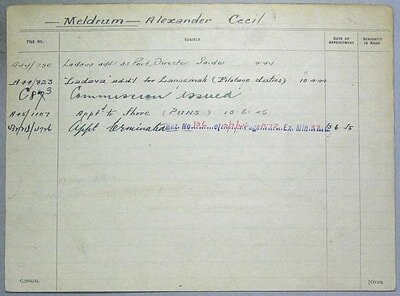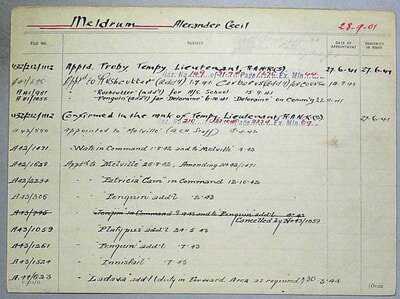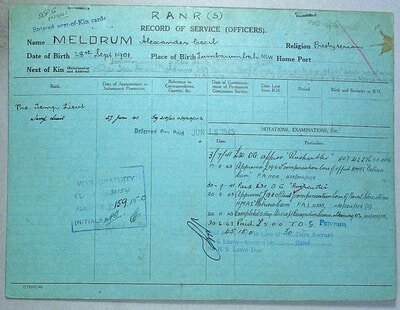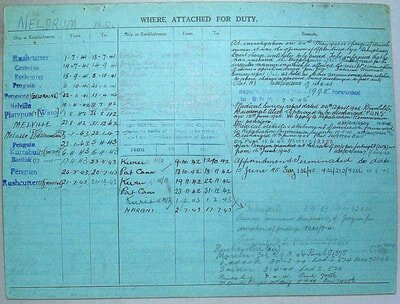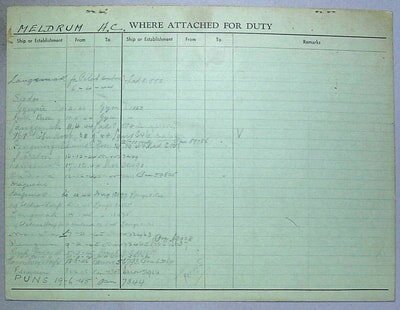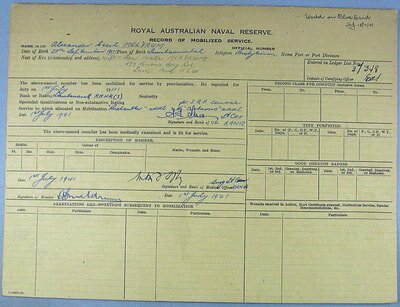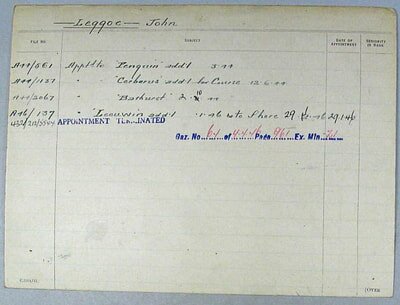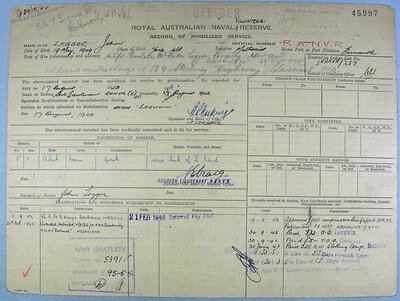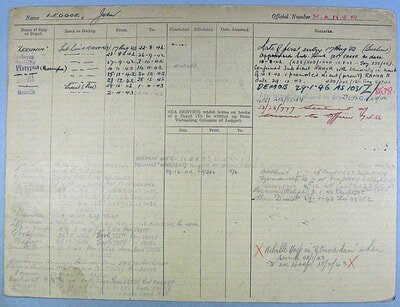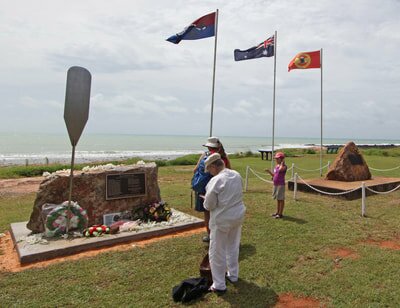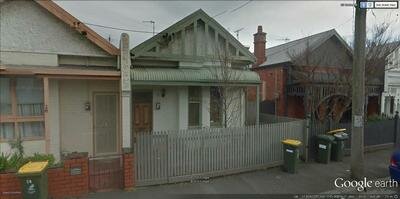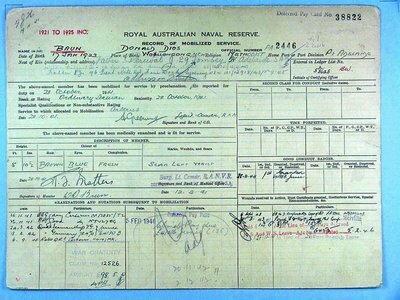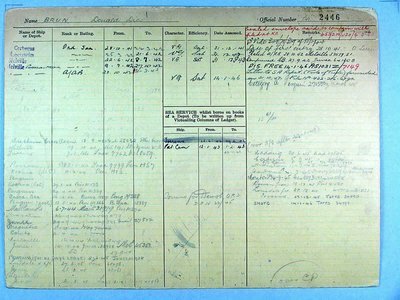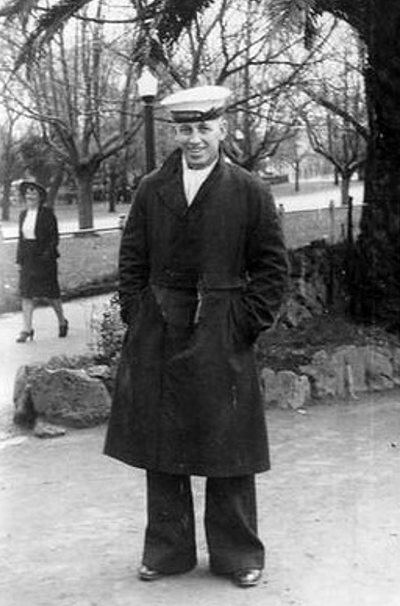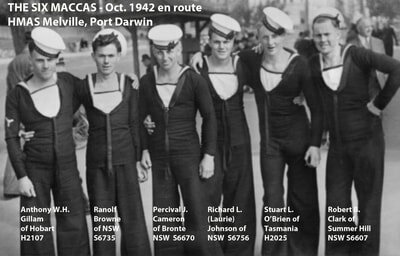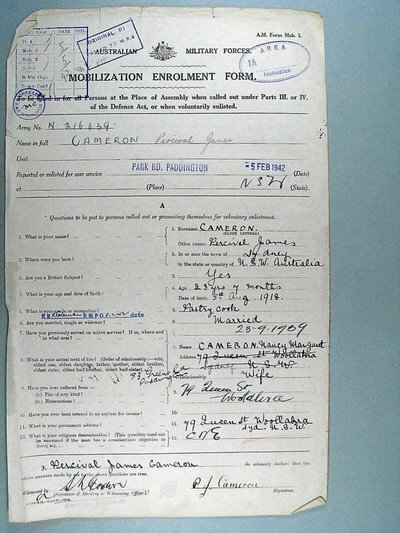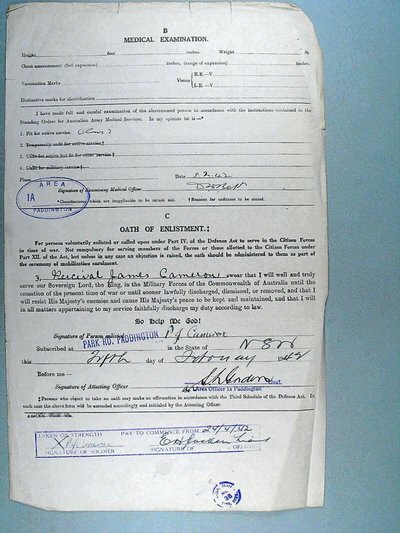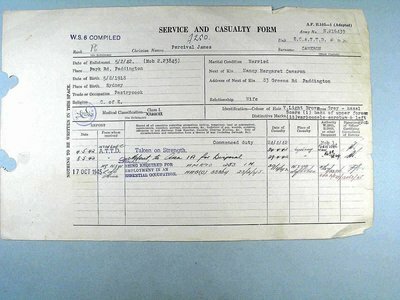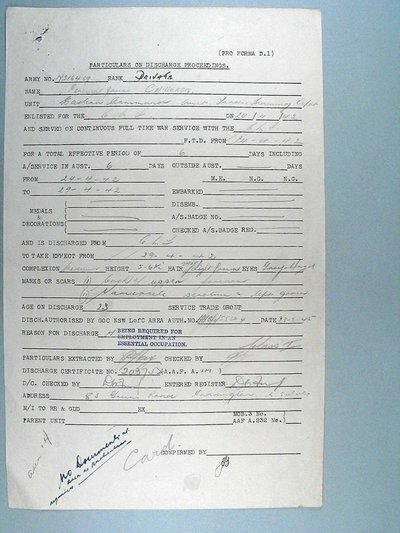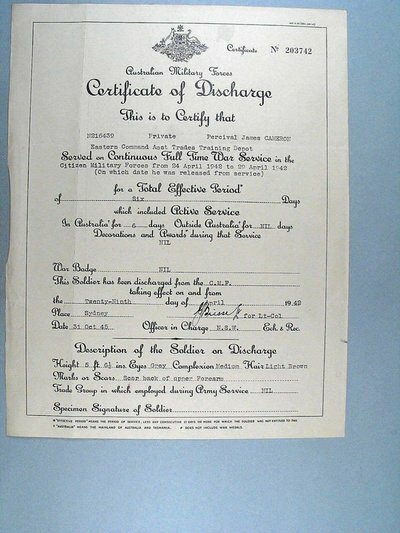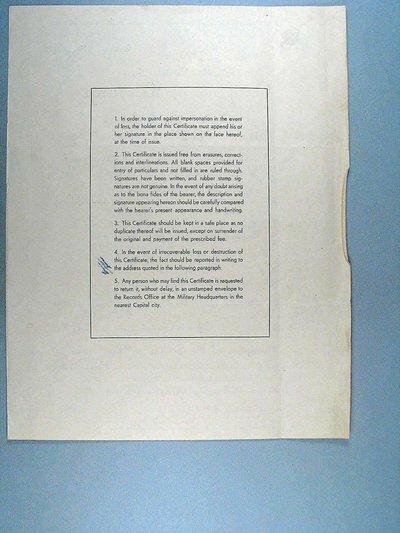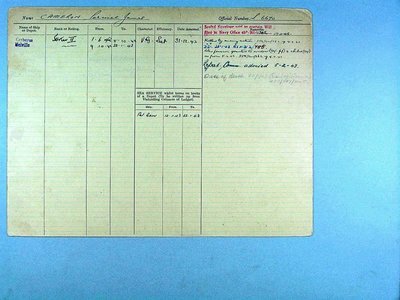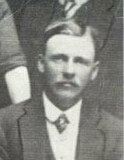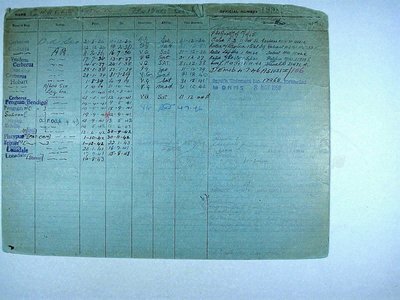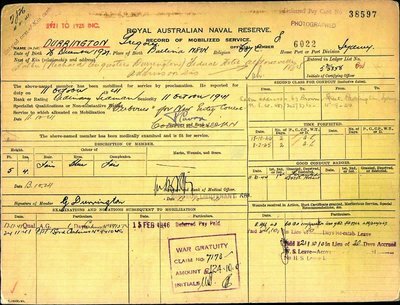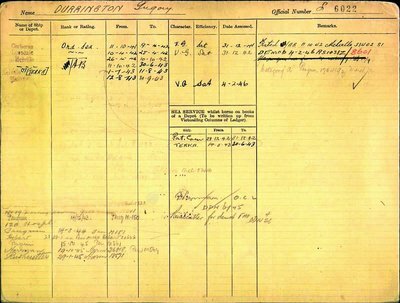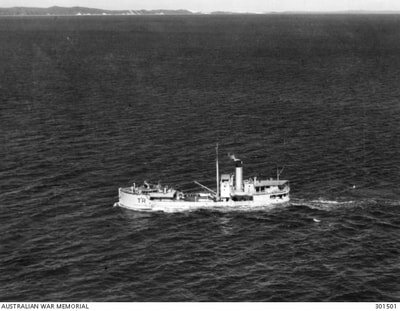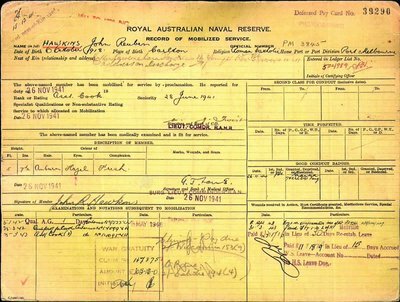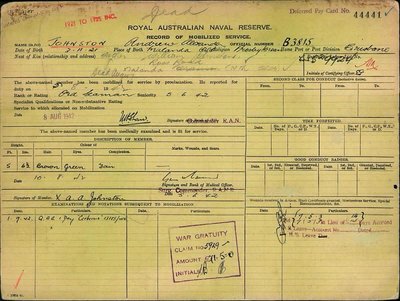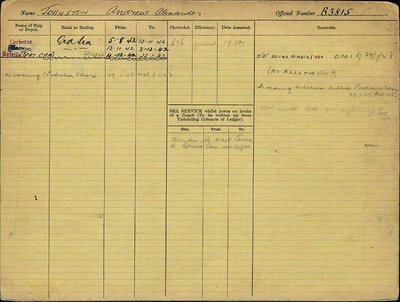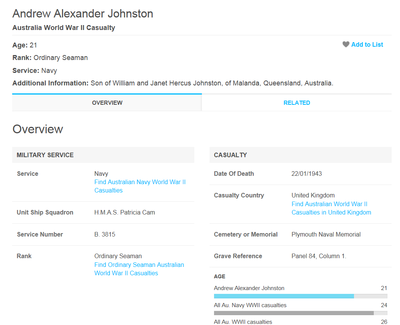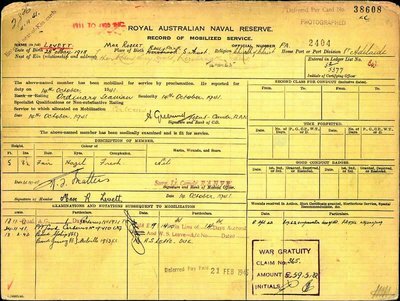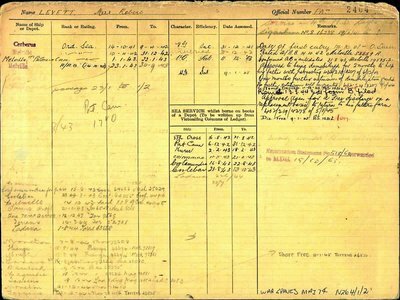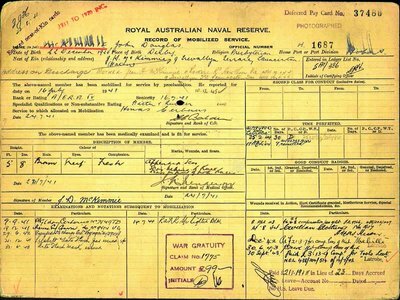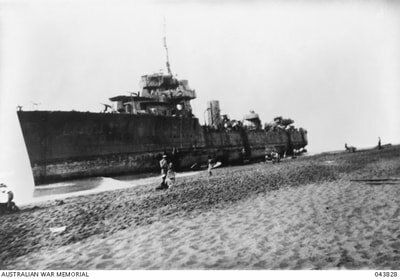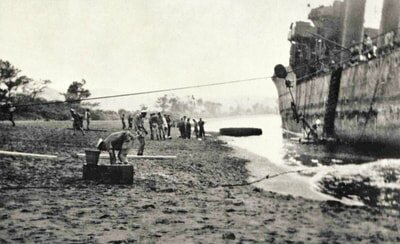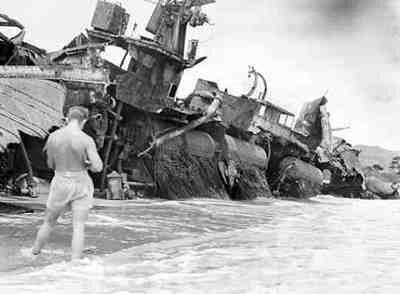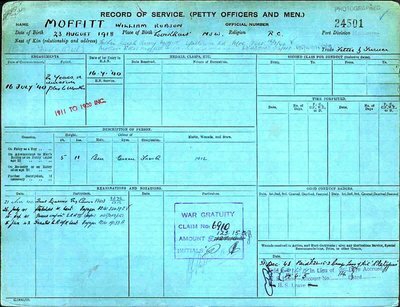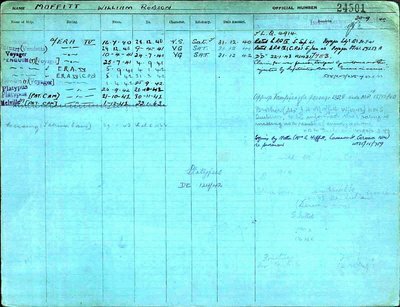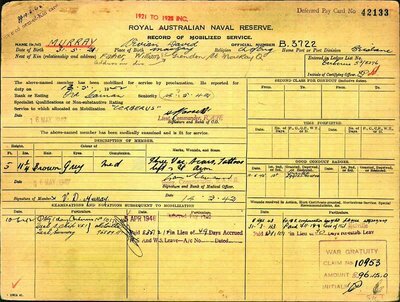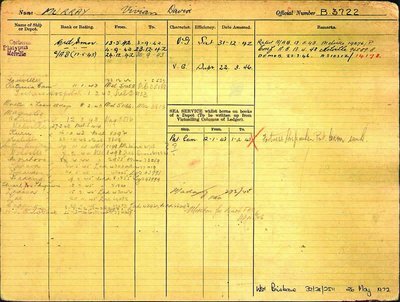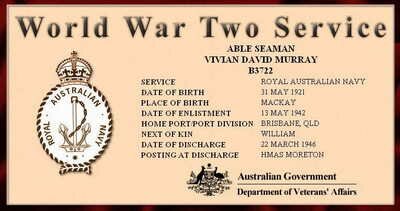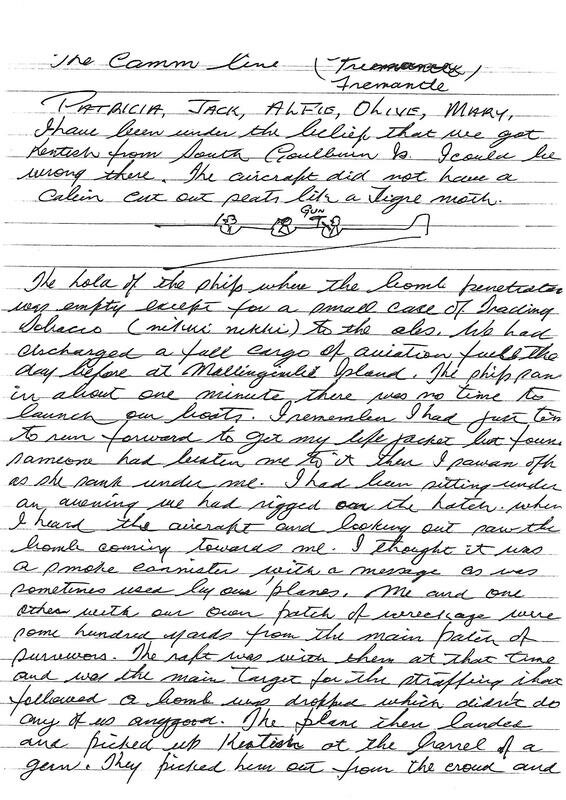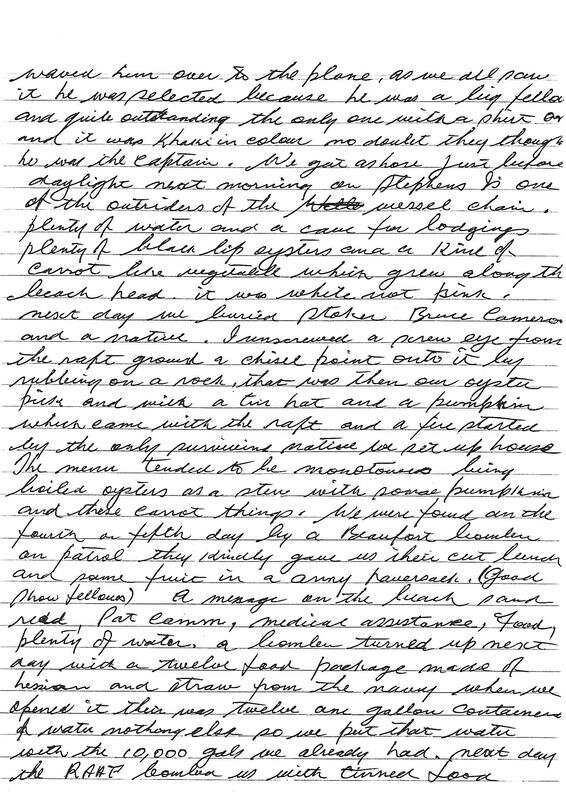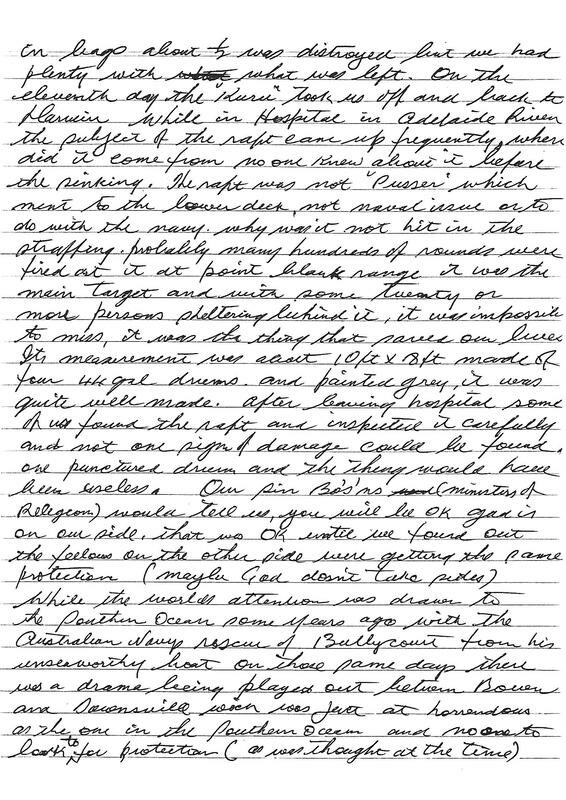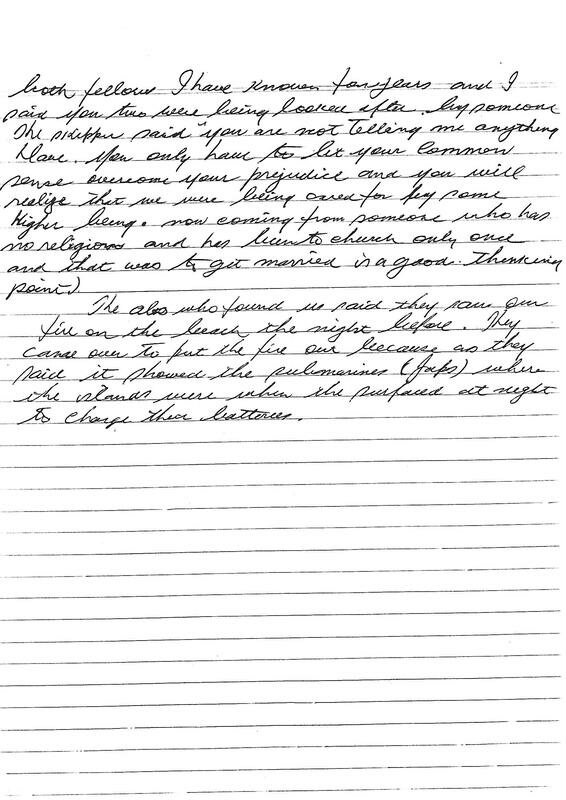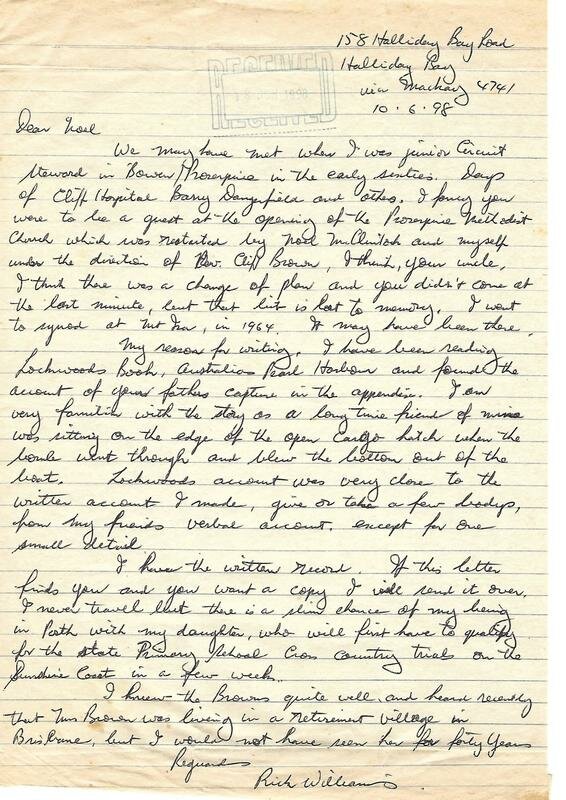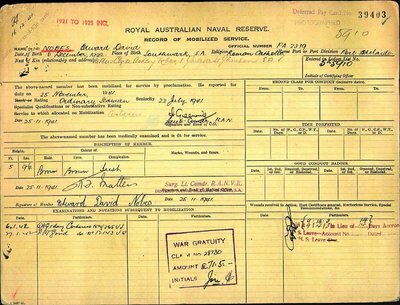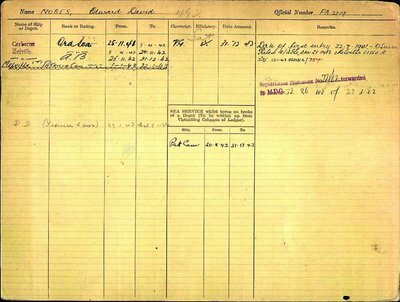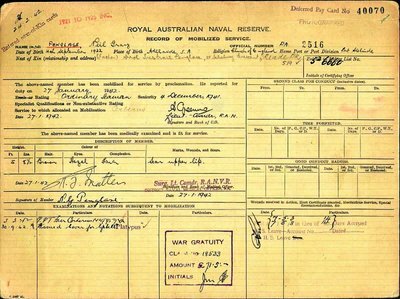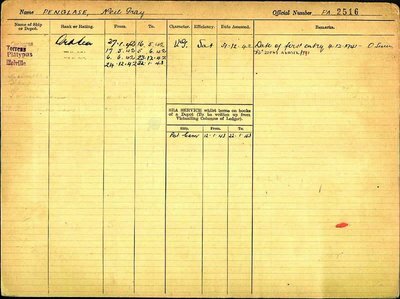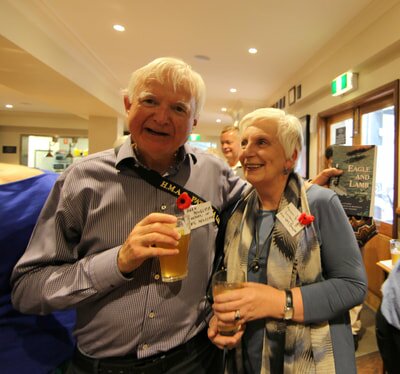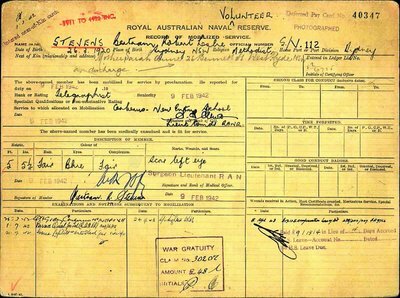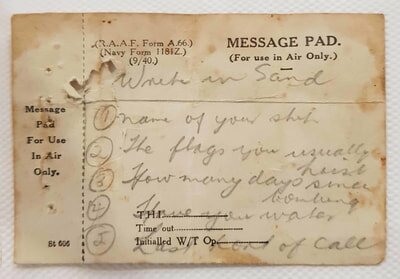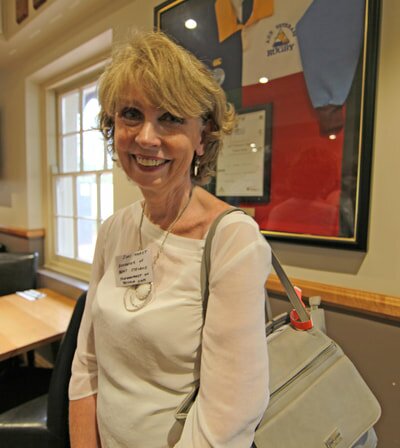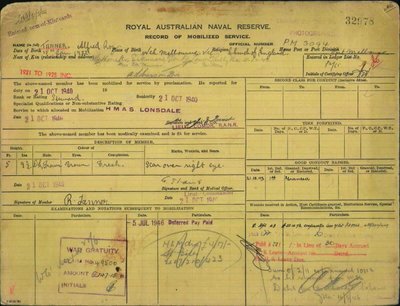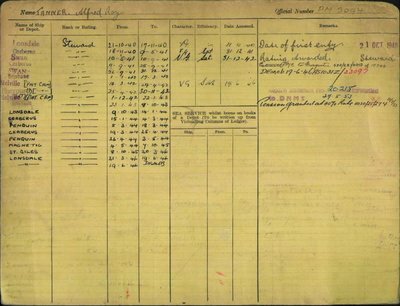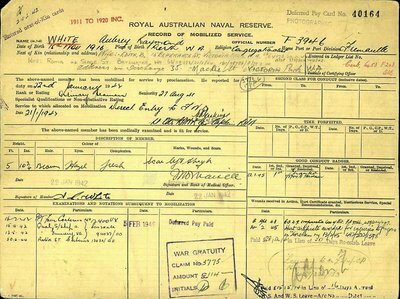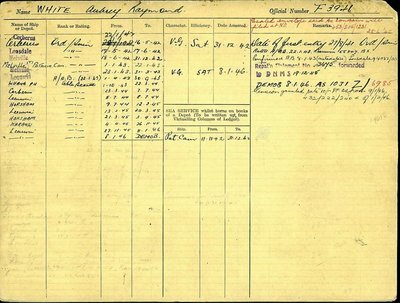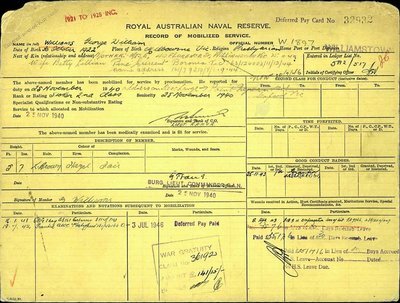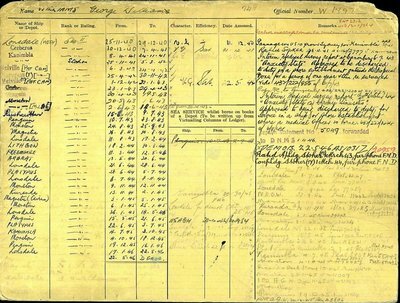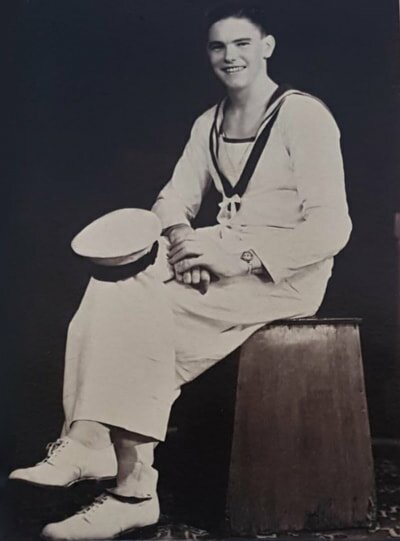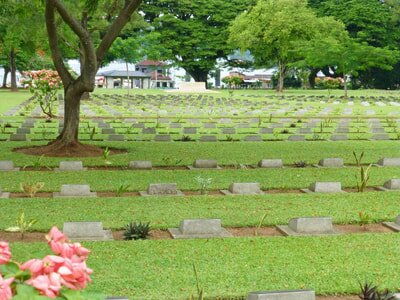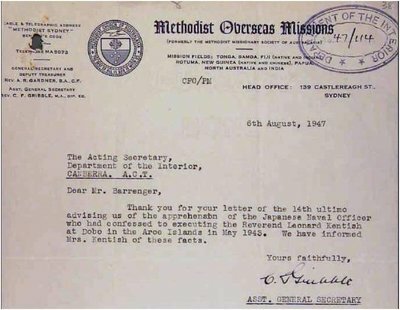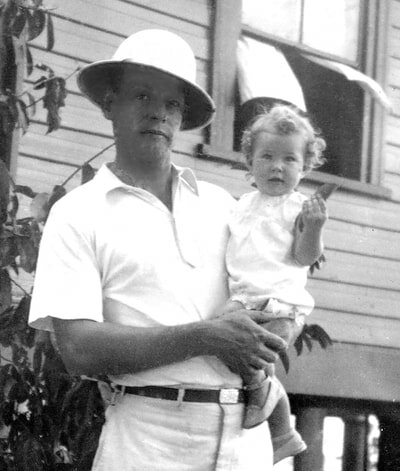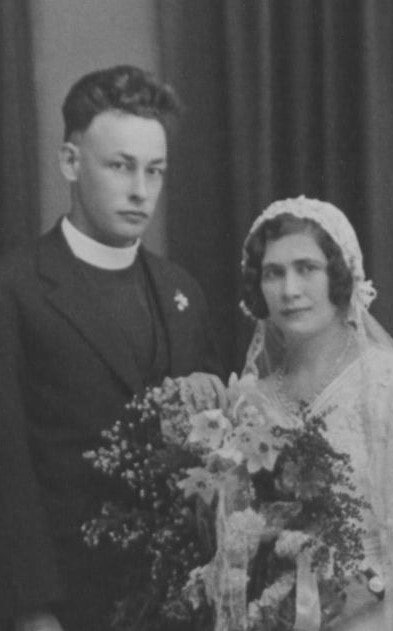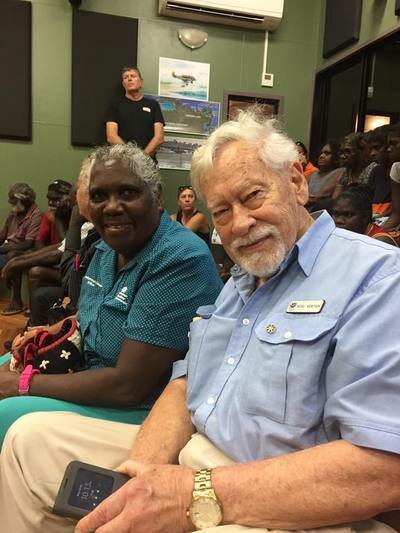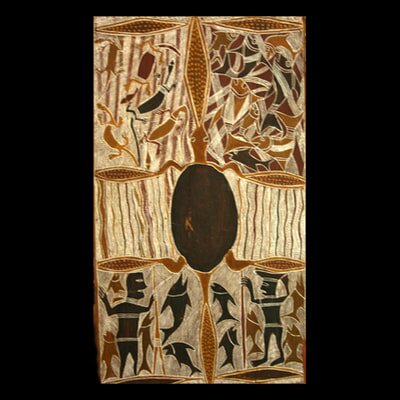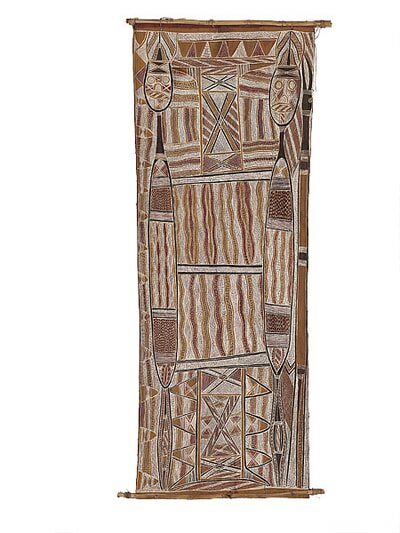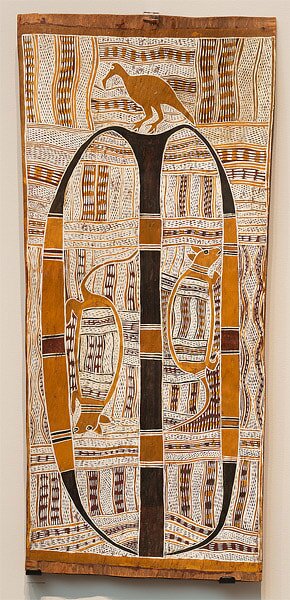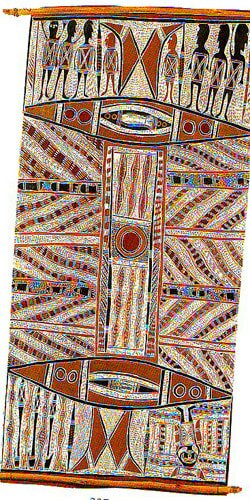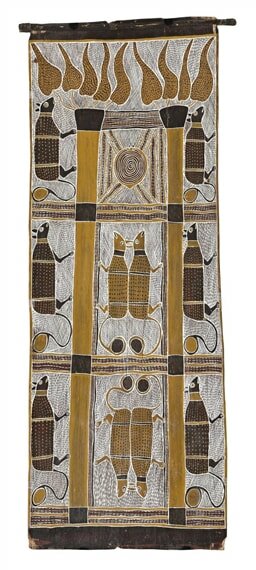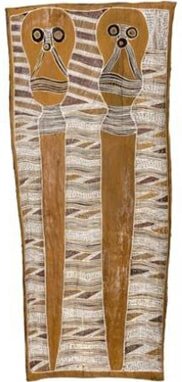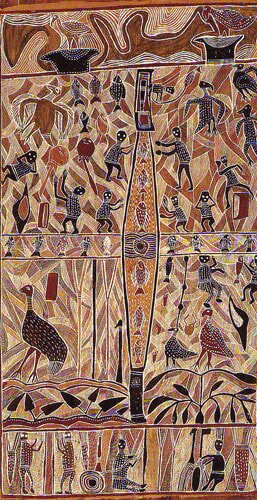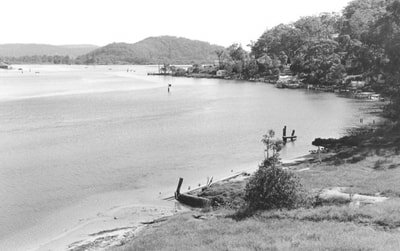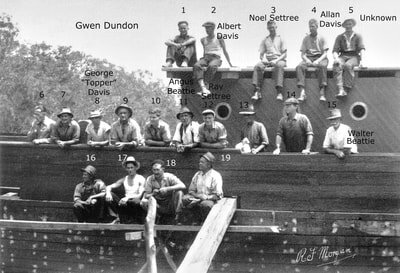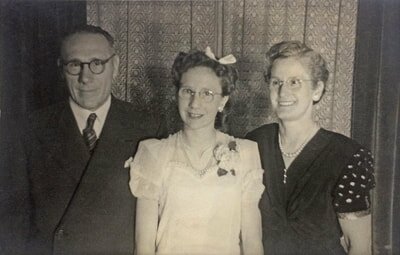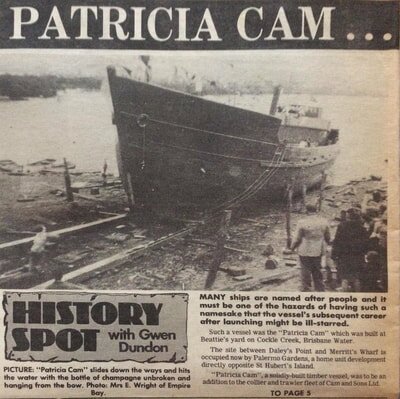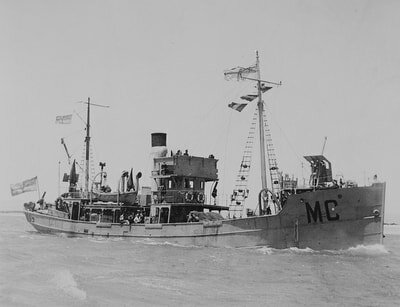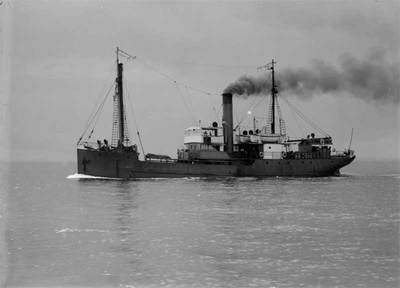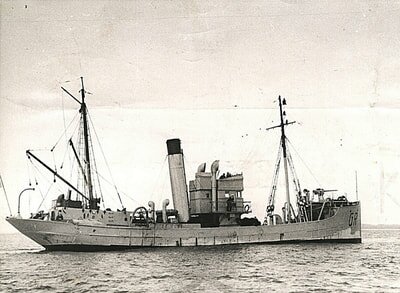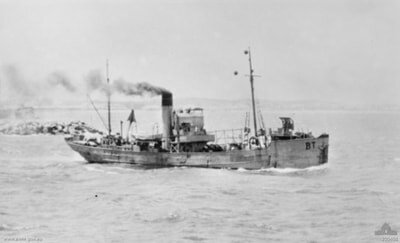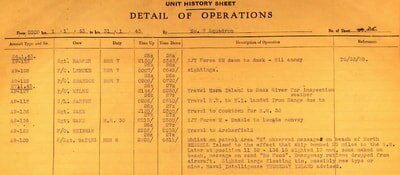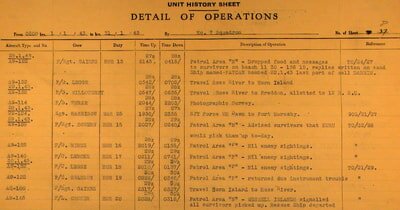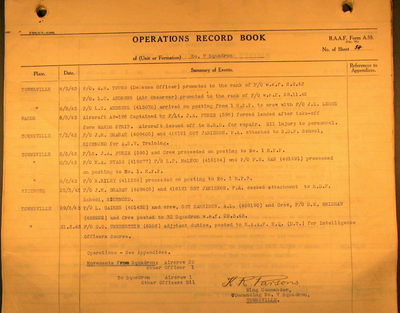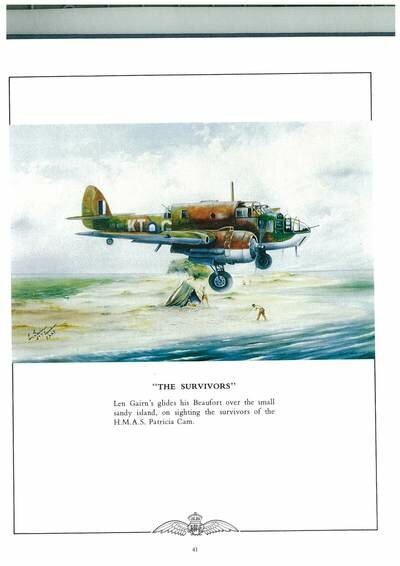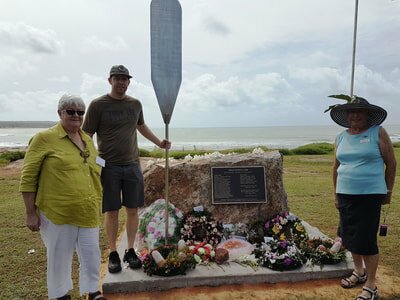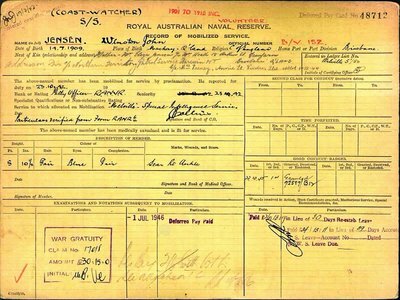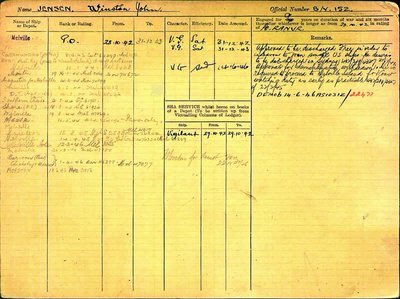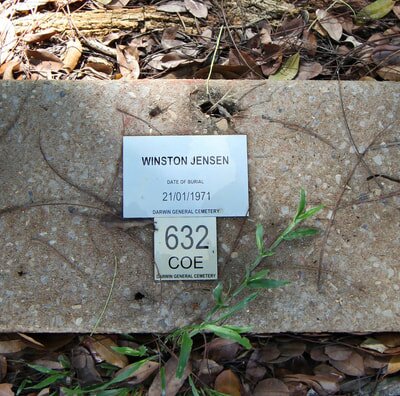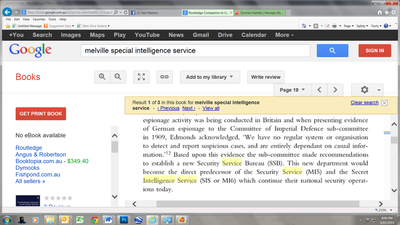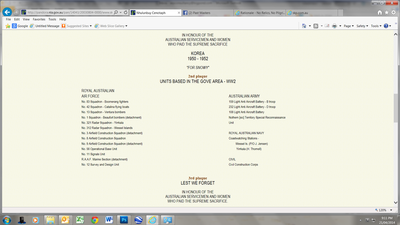HMAS PATRICIA CAM - THE MEN & THEIR FAMILIES et al
The purpose of this page is to record a summary of the lives of those immediately concerned with the Pat Cam. This website is part of the National Archives Pandora Project so is routinely archived to become a permanent record. Families are encouraged to provide a precis & images which they wish to display.
The Captain - Lieutenant Alexander C. 'Sandy' Meldrum RANR (S)
28th September 1901 - 6th January 1973
HMAS Deloraine's captain, Commander Menlove, was in hospital ashore with Dengue Fever when the Japanese attacked Darwin. She was moored off Stokes Hill wharf as her boilers were shutdown pending routine maintenance following convoy escort work to Thursday Island. She was thus immobile and commanded by the 2-i-C, Lieutenant Sandy Meldrum, who created such a 'favourable impression' supporting other vessels that had been attacked and sunk that he was subsequently given command of HMAS Patricia Cam which, within a year, would be sent to the bottom by a Japanese bomb.
 Alexander 'Sandy' Meldrum
Alexander 'Sandy' Meldrum
From:- the Extended Family of Alexander Meldrum
Albury WA 15/4/17
To:- Banambi Wunungmurra - President of East Arnhem Regional Council
First of all, thank you to the people of the East Arnhem Land Council for commemorating this event and having this ceremony and memorial at Yirrkala on 24th April 2017. I am writing on behalf of the extended family of the captain of the "Patricia Cam", Alexander (Sandy) Meldrum. He was our great uncle, but he had no children of his own. Please find included with this letter, copies of documents that we have had in our family possession for a number of years.
We used to see Alexander (Sandy) Meldrum later in his life, after the war, when he called into Port Kembla, where we lived, on various ships over his career. He did not talk much directly to us about his experience of the war, but there were two strong messages that we understood from him through our father.
The first and strongest message was his gratitude to the Aboriginal people who saved the lives of him and his crew, those that were not shot or lost at sea. Without their assistance no one would even know about this story. We were told of how, with the assistance of local Aboriginal people, the survivors were able to find enough food and water to stay alive. We were told that he was guided by Aboriginal people across the island to seek assistance from authorities, so that the rest of the crew could be rescued. Without the assistance of these wonderful and generous people, probably no one would have been able to return to their families. We are all eternally grateful and feel that the contribution of these wonderful Aboriginal people should be celebrated and acknowledged more broadly.
Albury WA 15/4/17
To:- Banambi Wunungmurra - President of East Arnhem Regional Council
First of all, thank you to the people of the East Arnhem Land Council for commemorating this event and having this ceremony and memorial at Yirrkala on 24th April 2017. I am writing on behalf of the extended family of the captain of the "Patricia Cam", Alexander (Sandy) Meldrum. He was our great uncle, but he had no children of his own. Please find included with this letter, copies of documents that we have had in our family possession for a number of years.
We used to see Alexander (Sandy) Meldrum later in his life, after the war, when he called into Port Kembla, where we lived, on various ships over his career. He did not talk much directly to us about his experience of the war, but there were two strong messages that we understood from him through our father.
The first and strongest message was his gratitude to the Aboriginal people who saved the lives of him and his crew, those that were not shot or lost at sea. Without their assistance no one would even know about this story. We were told of how, with the assistance of local Aboriginal people, the survivors were able to find enough food and water to stay alive. We were told that he was guided by Aboriginal people across the island to seek assistance from authorities, so that the rest of the crew could be rescued. Without the assistance of these wonderful and generous people, probably no one would have been able to return to their families. We are all eternally grateful and feel that the contribution of these wonderful Aboriginal people should be celebrated and acknowledged more broadly.
 L>R Noel Kentish, Norm Gramp, Jan Braund, Toby Brown - Darwin Military Museum - East Point.
L>R Noel Kentish, Norm Gramp, Jan Braund, Toby Brown - Darwin Military Museum - East Point.
The other person that we heard a little bit about was the Reverend who was on board, and was taken prisoner by the Japanese. We didn't know his name as children, but it was Rev. Kentish. The story we were told was that the Japanese didn't believe that great uncle Sandy was the captain, because he was dressed like all the other men on board. We had the impression that the Rev. Kentish however, was wearing his clerical collar and looked like the captain, so he was taken instead of our great uncle. So our thoughts are particularly with the son of Rev. Kentish, who we believe is conducting the service today. We are sorry for him, in that, if our uncle had looked more like a captain and was taken instead, he may have had his father around during his life.
Unfortunately, we didn't know about this event sooner. We would have liked some representative of the family to be there in person to thank the descendants of Balanda and Yolngu people whose forebears personally helped our great uncle and the crew of the "Patricia Cam". We would also like to thank Rev. Noel Kentish for being able to be there to commemorate this largely forgotten event.
Regards Sally Hendy
On Behalf of Barbara Catchpole, Libby Brown, Judy Fulham, Margaret Johnson - Daughters of Geoffrey Edgar Meldrum (nephew of Alexander Meldrum) & Toby Brown (great great nephew of Alexander Meldrum). [Toby Brown attended the events at Yirrkala & Darwin in April 2017].
Unfortunately, we didn't know about this event sooner. We would have liked some representative of the family to be there in person to thank the descendants of Balanda and Yolngu people whose forebears personally helped our great uncle and the crew of the "Patricia Cam". We would also like to thank Rev. Noel Kentish for being able to be there to commemorate this largely forgotten event.
Regards Sally Hendy
On Behalf of Barbara Catchpole, Libby Brown, Judy Fulham, Margaret Johnson - Daughters of Geoffrey Edgar Meldrum (nephew of Alexander Meldrum) & Toby Brown (great great nephew of Alexander Meldrum). [Toby Brown attended the events at Yirrkala & Darwin in April 2017].
Judith Meldrum (Niece) recalls:-
I remember uncle Sandy as a wonderful calm person, but he had no children.
His parents were Henry James Meldrum, schoolteacher (Dunfermline, Scotland) and Ellen E Bush, he was the youngest child of 11.
Noted his wife as Ira, (nee Little), however Aunty Mattie, from NZ, known to us as his wife. No children. Died in Chatswood, NSW but unsure of the date .
After WW2 he was in the merchant navy and captained ships around the Australian coast.
I believe he used to see a number of the crew from the Pat Cam on his voyages including in Perth and Adelaide.
He would often call into Port Kembla and visit his nephew, my father Geoff Meldrum, as well as his brother Tom at Bulli. Our extended family have, for many years, known about the story of the “Patricia Cam“. I now have Uncle Sandy’s sea chest from his time after WW2.
I remember uncle Sandy as a wonderful calm person, but he had no children.
His parents were Henry James Meldrum, schoolteacher (Dunfermline, Scotland) and Ellen E Bush, he was the youngest child of 11.
Noted his wife as Ira, (nee Little), however Aunty Mattie, from NZ, known to us as his wife. No children. Died in Chatswood, NSW but unsure of the date .
After WW2 he was in the merchant navy and captained ships around the Australian coast.
I believe he used to see a number of the crew from the Pat Cam on his voyages including in Perth and Adelaide.
He would often call into Port Kembla and visit his nephew, my father Geoff Meldrum, as well as his brother Tom at Bulli. Our extended family have, for many years, known about the story of the “Patricia Cam“. I now have Uncle Sandy’s sea chest from his time after WW2.
NOTES
Scored 91% for navigation
SS Mallinia 2nd Mate JG Steamships
1930 Subdivision of Artarmon – Fife, Gordon Road, Chatswood seaman M
Hunters Hill – Lane Cove – 47 Ryde Road, master mariner M
1948 Flat 21, Conway Court, 4 Blue St North Sydney master mariner M
Name: Alexander Cecil ‘Sandy’ Meldrum
Birth Date: 28 Sep 1901
Birth Place: Tumbarumbah New South Wales
Next of Kin: Isa Meldrum
Series Description: A6769: RAN, Navy Officers
Wife Isa Adele 397 Burns Bay Road Lane Cove NSW
Sea time on Kuru 19/11/42 to 22/11/42
Pat Cam 23/11/42 – 31/12/42
Kuru 1/2/42 – 1/2/42r
Charged with drunkenness 24 May 1943 – charge dropped – incurred displeasure of Navy Board – Medical reported nervous condition related to drunkenness charge. 15 June 1945 Duodenal Ulcer – Discharged PUNS – Granted War Pension
10 siblings – he was youngest
Died Chatswood NSW
Scored 91% for navigation
SS Mallinia 2nd Mate JG Steamships
1930 Subdivision of Artarmon – Fife, Gordon Road, Chatswood seaman M
Hunters Hill – Lane Cove – 47 Ryde Road, master mariner M
1948 Flat 21, Conway Court, 4 Blue St North Sydney master mariner M
Name: Alexander Cecil ‘Sandy’ Meldrum
Birth Date: 28 Sep 1901
Birth Place: Tumbarumbah New South Wales
Next of Kin: Isa Meldrum
Series Description: A6769: RAN, Navy Officers
Wife Isa Adele 397 Burns Bay Road Lane Cove NSW
Sea time on Kuru 19/11/42 to 22/11/42
Pat Cam 23/11/42 – 31/12/42
Kuru 1/2/42 – 1/2/42r
Charged with drunkenness 24 May 1943 – charge dropped – incurred displeasure of Navy Board – Medical reported nervous condition related to drunkenness charge. 15 June 1945 Duodenal Ulcer – Discharged PUNS – Granted War Pension
10 siblings – he was youngest
Died Chatswood NSW
Hey Mike, make sure you go to the Italian Chapel, Churchill Barriers!,and did you go past Oldmeldrum!!,or to Dunfermline, and the museum where the Meldrum Loom is. It was designed by the great or greater grandfather of Alexander Meldrum, captain of the Pat Cam.!! Judy Fulham
|
|
|
||||||||||||||||||
|
|
|
||||||||||||||||||
First Lieutenant John Leggoe RANVR

Conversation with Peter Leggoe 31/10/2014
Mt Pleasant WA 6153
Peter (91yo) youngest brother of John (JL) who died 94yo. Peter was in the Army - JL on corvette HMAS Bathurst
JL was on bunk with no shirt on when Jap bomb hit – so when in water it was Kentish in a shirt with gold cross on his collar that was taken – JL never said but PL thinks JL lifelong regret (‘weighed on his mind’) for not owning up as it was an officer that they sought.
After JL's book 'Trying to be Sailors' was published a short wiry man (not an officer – other ranks) turned up on the doorstep with a bottle of whiskey – he had relatives in Perth area so visited every year for a long time. PL corresponded on JL’s death but can’t remember his name. (was this Bennett).
The publisher Malcolm JL Uren’s mother was Peter Leggoe’s father’s sister, Minnie. John Leggoe is the family name in each generation after the missionary ancestor. So MJLU & JL are related.
Leggoe is Cornish – grandfather Rev John Leggoe, came out as missionary to the Cornish Miners at Moonta in SA – thence to Fiji as missionary where PL’s father was born – he had 4 children Joan, John, Frank & Peter. Frank had a son Jeremy an academic in US for years now UWA.
Received letter from man in England who served on HMS Maidstone which was a corvette mother ship & visited Darwin – he knew JL in the war.
JL had farmed in the Beauford River area WA but overcapitalised & had to walk off in the depression. After the war he got a block at Arthur River (18miles from old place). JL had two daughters – died early of cancer the other was a vet Dr Margaret Mary Leggoe in Sydney.
Mt Pleasant WA 6153
Peter (91yo) youngest brother of John (JL) who died 94yo. Peter was in the Army - JL on corvette HMAS Bathurst
JL was on bunk with no shirt on when Jap bomb hit – so when in water it was Kentish in a shirt with gold cross on his collar that was taken – JL never said but PL thinks JL lifelong regret (‘weighed on his mind’) for not owning up as it was an officer that they sought.
After JL's book 'Trying to be Sailors' was published a short wiry man (not an officer – other ranks) turned up on the doorstep with a bottle of whiskey – he had relatives in Perth area so visited every year for a long time. PL corresponded on JL’s death but can’t remember his name. (was this Bennett).
The publisher Malcolm JL Uren’s mother was Peter Leggoe’s father’s sister, Minnie. John Leggoe is the family name in each generation after the missionary ancestor. So MJLU & JL are related.
Leggoe is Cornish – grandfather Rev John Leggoe, came out as missionary to the Cornish Miners at Moonta in SA – thence to Fiji as missionary where PL’s father was born – he had 4 children Joan, John, Frank & Peter. Frank had a son Jeremy an academic in US for years now UWA.
Received letter from man in England who served on HMS Maidstone which was a corvette mother ship & visited Darwin – he knew JL in the war.
JL had farmed in the Beauford River area WA but overcapitalised & had to walk off in the depression. After the war he got a block at Arthur River (18miles from old place). JL had two daughters – died early of cancer the other was a vet Dr Margaret Mary Leggoe in Sydney.
“That night Commander Tozer told me that I had been appointed Executive Officer of Coonawarra, a naval wireless station five miles out of the town on the main road south. It was an odd kind of job. Before the Blitz Coonawarra had been a unit of the Naval Shore Wireless Service, a naval establishment manned by civilians, many of whom were telegraphists who had retired from long permanent naval service. The station, therefore, had civilian accommodation – individual tropical bungalows set on high concrete stilts, comfortable and well appointed. It was built on ten acres fronting the main north-south highway and past the front gate ran the Darwin-Birdum railway, the pipeline from Manton Dam to Darwin and the main southerly power line. Adjoining us on the Darwin side was the Winnellie army supply complex while on the other side was an army 3.7in ack-ack battery. Beyond the battery a road turned south to the Berrimah Hospital and the RAAF Fighter Sector Headquarters. The road led on to the quarantine station on East Arm, where there was another ack-ack battery.
Two other establishments which were part of Coonawarra were a direction-finding station half a mile into the bush across the railway, and the transmitting station three miles down the road at Coonawarra East, where half a dozen technical petty officers and chiefs lived in splendid isolation. There was also at Adelaide River a shadow station established after the Blitz for use in the event of Darwin being invaded. Here a few hands lived a hermit-like existence. By the time I reached Coonawarra they had been virtually forgotten and that probably suited them.
The main Coonawarra station consisted of the receiving station with its associated masts, a storage shed, an army type recreation hut and a dozen or so tropical bungalows set on high concrete stilts. A gravel driveway ran from the front gate a couple of hundred yards to the receiving station and halfway down its length this was intersected at right angles by a second driveway. At the intersection stood a small guardhouse and the white ensign fluttered from a tall steel flagpole. The neat bungalows were located up and down the driveways and in the rich red soil most of them sported small gardens of tomatoes, cucumbers and melons as well as bananas and pap-paw trees which grew like weeds in the wet season. There was a tennis court and in the bush between us and Winnellie was strung the screen for the bush cinemas which played such a big part in the lives of all services in the Northern Territory.
When the civilian staff and their families were sent south after the Blitz the station was manned by serving naval personnel with a commissioned warrant telegraphist as Officer in Charge. He was Skip Wilmetts, or Shorty, a short sardonic man in his late forties with a lifetime of experience with the navy. After long years of permanent service as a telegraphist he had retired with the rank of commissioned warrant officer and taken a comfortable civil job with the Shore Wireless Service at Canberra, where he had built his home. To be plucked from this, recommissioned in the navy and sent to Darwin in charge of a wartime Coonawarra had left Skip with a large chip on his shoulder.
Skip guarded his little domain at Coonawarra against intrusions from the top brass in Darwin as jealously as Commander Chook Fowler guarded his authority over the Boom. Anyone who had risen from the lower deck to become a commissioned warrant officer is a master of naval politics and intrigue, Skip was no exception and he knew to a hair’s breadth how far he could go in needling and insulting the brass hats in Darwin and get away with it. The fact that he felt himself a civilian press-ganged back into service made him even more contemptuous of his Darwin superiors, who were out of their depth in the technology of the Shore Wireless Service. As a result a sort of armed truce existed between Coonawarra and HMAS Melville and we were largely left to ourselves.”
Two other establishments which were part of Coonawarra were a direction-finding station half a mile into the bush across the railway, and the transmitting station three miles down the road at Coonawarra East, where half a dozen technical petty officers and chiefs lived in splendid isolation. There was also at Adelaide River a shadow station established after the Blitz for use in the event of Darwin being invaded. Here a few hands lived a hermit-like existence. By the time I reached Coonawarra they had been virtually forgotten and that probably suited them.
The main Coonawarra station consisted of the receiving station with its associated masts, a storage shed, an army type recreation hut and a dozen or so tropical bungalows set on high concrete stilts. A gravel driveway ran from the front gate a couple of hundred yards to the receiving station and halfway down its length this was intersected at right angles by a second driveway. At the intersection stood a small guardhouse and the white ensign fluttered from a tall steel flagpole. The neat bungalows were located up and down the driveways and in the rich red soil most of them sported small gardens of tomatoes, cucumbers and melons as well as bananas and pap-paw trees which grew like weeds in the wet season. There was a tennis court and in the bush between us and Winnellie was strung the screen for the bush cinemas which played such a big part in the lives of all services in the Northern Territory.
When the civilian staff and their families were sent south after the Blitz the station was manned by serving naval personnel with a commissioned warrant telegraphist as Officer in Charge. He was Skip Wilmetts, or Shorty, a short sardonic man in his late forties with a lifetime of experience with the navy. After long years of permanent service as a telegraphist he had retired with the rank of commissioned warrant officer and taken a comfortable civil job with the Shore Wireless Service at Canberra, where he had built his home. To be plucked from this, recommissioned in the navy and sent to Darwin in charge of a wartime Coonawarra had left Skip with a large chip on his shoulder.
Skip guarded his little domain at Coonawarra against intrusions from the top brass in Darwin as jealously as Commander Chook Fowler guarded his authority over the Boom. Anyone who had risen from the lower deck to become a commissioned warrant officer is a master of naval politics and intrigue, Skip was no exception and he knew to a hair’s breadth how far he could go in needling and insulting the brass hats in Darwin and get away with it. The fact that he felt himself a civilian press-ganged back into service made him even more contemptuous of his Darwin superiors, who were out of their depth in the technology of the Shore Wireless Service. As a result a sort of armed truce existed between Coonawarra and HMAS Melville and we were largely left to ourselves.”
Ist Lieutenant John Leggoe RNVR was a staff reporter on the West Australian newspaper - Malcolm John Leggoe Uren was editor-in-chief of West Australian Newspapers' associated publications. Malcolm JL Uren was involved in clandestine operations during WW2. 1st Lt. John Leggoe returned to the paper at the end of the war and one day a letter was passed to him from the Chief of Staff, Stan Rosier, as the basis for a possible story. It was from Mrs Violet Kentish asking that it be publish in the hope of a newly returned PoW having information concerning the fate of her husband the Rev. Dr. Leonard Kentish. He recalled that a Japanese floatplane had been shot down whilst attacking the Wilcannia convoy in 1943 and had read of their interrogation whilst at Coonawarra in Darwin. Suspecting that they were from the same squadron that sank the Pat Cam and captured Kentish - he notified the authorities and 18 months later in 1947 was asked to identify a picture of the Rev. Kentish and make a statement for the up-coming War Crimes trial which he swore next morning before the Commonwealth Crown Solicitor HFE Whitlam, father of Gough Whitlam who served at Gove as a RAAF Navigator.
|
|
|
|
||||||||||||||||||||||||
Stoker Arthur Robert Bennett RANR

Ron & Pat Sturgeon of Victoria
Pat writes: Arthur Robert Bennett was my uncle. Younger brother of my mother, Joyce. My cousins are Michael and Susan (the children of Arthur & his wife Shirley). My older brother is Norman Arthur. We have tracked down Arthur’s son, Michael Bennett via another cousin, Mark Bennett (whose father Jack was Arthur’s fraternal twin).
Whomever Jan Braund met in Sydney in 1960, it certainly wasn’t our Uncle Arthur. My brother Norm remembers that Arthur was working with EA Watts here in Melbourne at that time and also building a house at Upwey during that period. Norm seems to think there was another Arthur in the crew.
Pat writes: Arthur Robert Bennett was my uncle. Younger brother of my mother, Joyce. My cousins are Michael and Susan (the children of Arthur & his wife Shirley). My older brother is Norman Arthur. We have tracked down Arthur’s son, Michael Bennett via another cousin, Mark Bennett (whose father Jack was Arthur’s fraternal twin).
Whomever Jan Braund met in Sydney in 1960, it certainly wasn’t our Uncle Arthur. My brother Norm remembers that Arthur was working with EA Watts here in Melbourne at that time and also building a house at Upwey during that period. Norm seems to think there was another Arthur in the crew.
| arthur_l_bennett_gen_notes.pdf | |
| File Size: | 653 kb |
| File Type: | |
Able Seaman Donald Dios Brun RANR

Wendy Ceravolo (niece), Kevin Dios-Brun (son) & Lorraine Learinan (daughter)
Name: Donald Dios Brun
Birth Date: 17 Jan 1923
Birth Place: Wollongong New South Wales
Enlistment Place: Port Adelaide Sa
Service number: PA2446
Next of Kin: Eileen Brun
Series Description: A6770: RAN, Petty Officers and Men
Good conduct badge 1st class 28/10/44
Father Percival John – 29 Tomsey St Adelaide SA still exists
In 1939 & 1943 he was living a baker at Lock SA
Wife Eileen a. 16 Lucas Road ??? could be NSW
Discharged to father’s address
Looks like “Not S/G [sea going] after 22-1-43
Contact kim_carlin Ancestry.com left message
Collin Dios-Brun Birth 04 NOV 1927 Death 28 JAN 2010 • Murray Bridge, SA
Diosbrun or Dios-Brun SA family
Birth Date: 17 Jan 1923
Birth Place: Wollongong New South Wales
Enlistment Place: Port Adelaide Sa
Service number: PA2446
Next of Kin: Eileen Brun
Series Description: A6770: RAN, Petty Officers and Men
Good conduct badge 1st class 28/10/44
Father Percival John – 29 Tomsey St Adelaide SA still exists
In 1939 & 1943 he was living a baker at Lock SA
Wife Eileen a. 16 Lucas Road ??? could be NSW
Discharged to father’s address
Looks like “Not S/G [sea going] after 22-1-43
Contact kim_carlin Ancestry.com left message
Collin Dios-Brun Birth 04 NOV 1927 Death 28 JAN 2010 • Murray Bridge, SA
Diosbrun or Dios-Brun SA family
| donald_dios_brun.pdf | |
| File Size: | 119 kb |
| File Type: | |
Stoker Percival James Cameron RANR

Percy’s daughter, Janice Lee Braund, recalls:- ‘After 74 years, looking for the remains of PJC, I have discovered that I really know very little about him. Whilst I was growing up, my mother never spoke of him. Over the years, some male relatives, on my mother’s side, spoke of him admiringly in relation to sport and particularly his stamina to box 10 rounds at Sydney Stadium, Rushcutters Bay, in about 1937-1940. He fought under the name of Dick Johnson, but no weight category was mentioned. He also played Australian Rules football - representing NSW against Queensland and Canberra. I have his Life Time Certificate with Eastern Suburbs AFL Club and newspaper articles with ‘action’ photographs. They loved the fact that he could swim underwater across Clovelly Bay; his Sunday rowing from Watson's Bay to Manly and back. Apparently, he also arranged picnics as he had a driver’s licence. It appears that he was quite a leader and a very popular man. His mother didn’t like the boxing, so he packed his bed with pillows and climbed out of the window to go and box.
‘Percy’s mother was Silvia Pearl Fisher and his father was John 'Allan' James Cameron, who was raised at Mendooran [near Dubbo] NSW. AJC 's father, John James Cameron, and wife came from Scotland as free settlers and over several years, made their way from Sydney to Mendooran. The family was highly respected in the area and have been written up as early pioneers.
‘Silvia and Allan divorced after Silvia left him for her first cousin. Siblings Jean and Percy went with the mother whilst Johanna and Silvia went with the Father.
‘PJC became engaged to Nancy Margaret Lee in 1939, marrying in 1940. They produced me, Janice Lee Cameron, on 18/02/1941. We lived at 37 Queen's St., Woollahra NSW. When PJC went into the forces the family went to live with Nancy's father at 94 Macpherson St., Bronte. [Nancy Cameron nee Lee b. 10.01.1921 d. 23.12.1962]
‘Growing up I rarely saw any of my father's relatives. No Birthday/ Christmas cards or gifts. I recall only once seeing Silvia, when I was 3 years old, at her home at Abbotsford NSW. She had a large birds cage in the yard and her magpie pecked my finger painfully. A family story told of Silvia telling my mother on the exact day that Percy died that she 'saw’ his cap floating on the water. The Navy contacted Mum weeks later. [Story from Edna, mum's sister]
‘Aged sixteen, Percy had asked permission to join the Navy but his father refused to sign the papers, so he became a pastry cook. He stated his preference to join the Navy and not the Army when he enlisted.
‘PJC and Nancy lived next door to John J. Cameron in Queens St. When I was born, PJC said to his brother that he now had to buy and play with dolls, while Jack had just produced a son and could play footy in the future. I never met any of Jack's sons. I never met either of Jean's two children. I often thought that this family was very strange or was there one of those awful family fall-outs not spoken about by anyone.
‘Growing up, PJC lived about 2 minutes from Trumper Park, in Paddington, where he played Aussie Rules. The Stadium was also within walking distance of the boxing gym in Woollahra whilst he worked in Paddington.
‘The Ultimo Tech fellow whom I met by chance in about 1960, told me the story of helping to bury my Dad and naming his daughter after me. He also said that my father carried a photograph of mum and myself with him.
‘December 1942, PJC posted to his mother a gold locket with enamelled RAN inlay and a gold brooch in the shape of a boomerang with Mother inscribed. My mother and I are photographed with her wearing the locket. I have both items. My Grandfather, Lee, made a 21st Birthday Key of about 9" long which my son Tony has, along with PJC's War Medals. I have photographs of both Mum and Dad, but many of them depict people I never knew.’
‘Percy’s mother was Silvia Pearl Fisher and his father was John 'Allan' James Cameron, who was raised at Mendooran [near Dubbo] NSW. AJC 's father, John James Cameron, and wife came from Scotland as free settlers and over several years, made their way from Sydney to Mendooran. The family was highly respected in the area and have been written up as early pioneers.
‘Silvia and Allan divorced after Silvia left him for her first cousin. Siblings Jean and Percy went with the mother whilst Johanna and Silvia went with the Father.
‘PJC became engaged to Nancy Margaret Lee in 1939, marrying in 1940. They produced me, Janice Lee Cameron, on 18/02/1941. We lived at 37 Queen's St., Woollahra NSW. When PJC went into the forces the family went to live with Nancy's father at 94 Macpherson St., Bronte. [Nancy Cameron nee Lee b. 10.01.1921 d. 23.12.1962]
‘Growing up I rarely saw any of my father's relatives. No Birthday/ Christmas cards or gifts. I recall only once seeing Silvia, when I was 3 years old, at her home at Abbotsford NSW. She had a large birds cage in the yard and her magpie pecked my finger painfully. A family story told of Silvia telling my mother on the exact day that Percy died that she 'saw’ his cap floating on the water. The Navy contacted Mum weeks later. [Story from Edna, mum's sister]
‘Aged sixteen, Percy had asked permission to join the Navy but his father refused to sign the papers, so he became a pastry cook. He stated his preference to join the Navy and not the Army when he enlisted.
‘PJC and Nancy lived next door to John J. Cameron in Queens St. When I was born, PJC said to his brother that he now had to buy and play with dolls, while Jack had just produced a son and could play footy in the future. I never met any of Jack's sons. I never met either of Jean's two children. I often thought that this family was very strange or was there one of those awful family fall-outs not spoken about by anyone.
‘Growing up, PJC lived about 2 minutes from Trumper Park, in Paddington, where he played Aussie Rules. The Stadium was also within walking distance of the boxing gym in Woollahra whilst he worked in Paddington.
‘The Ultimo Tech fellow whom I met by chance in about 1960, told me the story of helping to bury my Dad and naming his daughter after me. He also said that my father carried a photograph of mum and myself with him.
‘December 1942, PJC posted to his mother a gold locket with enamelled RAN inlay and a gold brooch in the shape of a boomerang with Mother inscribed. My mother and I are photographed with her wearing the locket. I have both items. My Grandfather, Lee, made a 21st Birthday Key of about 9" long which my son Tony has, along with PJC's War Medals. I have photographs of both Mum and Dad, but many of them depict people I never knew.’
A mounted and signed group portrait of Stokers' Class 229, at the Engineering School, Flinders Naval Depot, HMAS Cerberus. Identified back row from left: 26109 Edward John McMahon, of Tas; W2405 Alan Chester Kerr, of Vic; W2357 William Charles Newbound, of Vic; PA2741 Ronald George Birks, of SA; H2025 Stuart Lindsay O'Brien, of Tas; S6756 Richard Lawrence (Laurie) Johnson, of NSW; 34322 Keith Alan Grainger, of Qld; H2097 Roy George Patrick Graham, of Qld. Middle Row: F4257 Campbell G Walker, of WA; B3732 Francis John Goodman, of Qld; F4239 Maxwell James Skelton, of WA; R Pola, of WA; W2404 George Lacco, of Vic; S6573 Winton D Irving, of NSW; 26050 Ernest George Knell, of Vic; S6607 Robert Bruce Clark, of NSW; PA2842 Donald Vernon McDonald, of SA; Front Row: W2389 Kenneth Binner, of Vic; H2I07 Anthony W Gillam, of Tas; H2689 Desmond J Hansen, of Tas; 7242 Chief Stoker, Andrew Henley, Instructor; S6670 (& N216469) Percy J Cameron, of NSW; 26049 Michael B Crane, of Qld; S6735 Randolf Browne, of NSW.
|
Suzanne Figures family tree
Alexander Cameron 1784 -1855 married Janet White or Whyte 1782 - John Cameron 1816-1904 married Janet Watson 1816-1902 John Allan Cameron 1850-1936 married Mary Anne Copelan 1857-1928 John Allan James Cameron 1885-1940 married Sylvia Pearl Fisher 1895- Percival James Cameron 1919-1943 [born 1918 wed Nancy Lee 1921 -1962] Janice Lee Braund (nee Cameron) 1941- |
| emails___notes_-_war_graves_etc.pdf | |
| File Size: | 459 kb |
| File Type: | |
Petty Officer Hubert George Challender RAN

David, Ross and Paul Challender
When Hulbert George Challender was born on 27 December 1915 in Hobart, Tasmania, his father, David, was 30 and his mother, Annie, was 31. He married Aileen Jean Anthony on 30 April 1941 in his hometown. They had one child during their marriage. Hulbert died on 9 February 1985 at the age of 69.
Name: Hulbert George Challender
Birth Date: 27 Dec 1915
Birth Place: Hobart Tasmania
Enlistment Place: Melbourne
Service number: 19983
Next of Kin: Aileen Challender
Series Description: A6770: RAN, Petty Officers and Men
Birth: 27 December 1915 (27 Dec 1915) - Australia
Marriage: 30 Apr 1941 - Hobart, Tasmania, Australia
Death: 09 February 1985 (9 Feb 1985)
Parents: David Percival Bishop Challender, Annie Wilson
Birth Date: 27 Dec 1915
Birth Place: Hobart Tasmania
Enlistment Place: Melbourne
Service number: 19983
Next of Kin: Aileen Challender
Series Description: A6770: RAN, Petty Officers and Men
Birth: 27 December 1915 (27 Dec 1915) - Australia
Marriage: 30 Apr 1941 - Hobart, Tasmania, Australia
Death: 09 February 1985 (9 Feb 1985)
Parents: David Percival Bishop Challender, Annie Wilson
| hulbert_george_challender.pdf | |
| File Size: | 12 kb |
| File Type: | |
Able Seaman Gregory Durrington RANR

Greg's sisters were Norma Yvonne Durrington b 1923 d 26.9.2006 in Ballina, NSW. Norma served in WW2 as well. She married John Cassimar Treanor. They lived in Granville and then Ballina.
There are Treanors living in Chambigne near Grafton (Tim whi is away for 3 weeks and some at Roseberry Ck near Kyogle - left message.
Greg's other sister is Shirley Durrington who married Cyril James Connors. They lived in Lismore, NSW and their last known address via the electoral rolls was 125 Dibbs Street Lismore in 1980. I cannot find a death record for either of them in Australia.
There are Treanors living in Chambigne near Grafton (Tim whi is away for 3 weeks and some at Roseberry Ck near Kyogle - left message.
Greg's other sister is Shirley Durrington who married Cyril James Connors. They lived in Lismore, NSW and their last known address via the electoral rolls was 125 Dibbs Street Lismore in 1980. I cannot find a death record for either of them in Australia.
| greg_durrington_notes_9-12-17.pdf | |
| File Size: | 130 kb |
| File Type: | |
Cook, John Reuben Hawkins RANR

Post war John lived with mother Caroline Dora at 16 Young Street Kew, Victoria - less than a mile from Bennett. His father died when he was 3 years old. It appears that he never married & died without issue. Only very distant relatives have been identified.
HAWKINS John Reuben – PM3845 –
John Reuben Hawkins in the Australia, Death Index, 1787-1985
Birth Year: 6 Oct 1918 Carlton Victoria
Death Place: Kew, Victoria
Death Registration Year: 1971
Age: 52
Registration Number: 18048
Father's name: Herbert Arthur Hawkins (1891 - 15/6/1922) Geelong Eastern Cemetery
Mother's name: Caroline Dora Allen (1890-1965) Geelong Eastern Cemetery
John Reuben Hawkins in the Australia, Death Index, 1787-1985
Birth Year: 6 Oct 1918 Carlton Victoria
Death Place: Kew, Victoria
Death Registration Year: 1971
Age: 52
Registration Number: 18048
Father's name: Herbert Arthur Hawkins (1891 - 15/6/1922) Geelong Eastern Cemetery
Mother's name: Caroline Dora Allen (1890-1965) Geelong Eastern Cemetery
|
|||||||
Ordinary Seaman Andrew Alexander Johnston RAN
 Andrew A Johnston
Andrew A Johnston
Heather (nee Johnston) & Arthur Farren-Price - Andy & Stan Johnston
Andrew was born on 3rd November, 1921 in Atherton, North Queensland, to William & Janet Johnston. Andrew was the third of four sons who grew up on their family farm at Butchers Creek, via Malanda, and were well known in the area for their sporting abilities i.e. cricket and tennis. Andrew did very well at his schooling and was awarded with a Bursary to attend Gatton Agricultural College, Gatton, South Queensland. Andrew again excelled with his studying and was appointed to the teaching staff at this College.
From Gatton, Andrew enlisted in the Royal Australian Navy on 5th June, 1942 and reported for duty on 5th August, 1942 to HMAS Cerberus as Ordinary Seaman. After serving three months at HMAS Cerberus, Andrew was then transferred to another Royal Australia Navy facility from 13th November to 3rd December 1942, then to HMAS Melville, Darwin, for three weeks duty. HMAS Melville was originally a naval depot - named HMAS PENGUIN V - which opened in Darwin in January 1935 with a primary mission of operating as a naval reserve facility. HMAS Melville was commissioned by the Australian Navy on 1 August, 1940. Andrew was then transferred to HMAS Patricia Cam on 4th December, 1942 until his death on 22 January, 1943. Patricia Cam had been requisitioned by the Royal Australian Navy on 9th February 1942 and commissioned on 3rd March 1942 for supplies and minesweeper activities north of Arnhem Land.
On 22nd January, 1943, Patricia Cam was bombed by a Japanese seaplane and sank immediately. Andrew, along with many others from the Patricia Cam, survived the initial attack but was to suffer another attack by the seaplane when three more personnel were killed.
Andrew and another crewman, Chief ERA William Moffitt, were seen clinging to one of Patricia Cam’s hatches but, after nightfall, contact with Andrew & his companion was lost and they were not seen again. Andrew had celebrated his 21st birthday only two months previous. Andrew was unmarried.
Andrew’s name is located on a panel in the Commemorative Area at the Australian War Memorial, Canberra and the Plymouth Naval Memorial, Plymouth, Devon, England.
Andrew was born on 3rd November, 1921 in Atherton, North Queensland, to William & Janet Johnston. Andrew was the third of four sons who grew up on their family farm at Butchers Creek, via Malanda, and were well known in the area for their sporting abilities i.e. cricket and tennis. Andrew did very well at his schooling and was awarded with a Bursary to attend Gatton Agricultural College, Gatton, South Queensland. Andrew again excelled with his studying and was appointed to the teaching staff at this College.
From Gatton, Andrew enlisted in the Royal Australian Navy on 5th June, 1942 and reported for duty on 5th August, 1942 to HMAS Cerberus as Ordinary Seaman. After serving three months at HMAS Cerberus, Andrew was then transferred to another Royal Australia Navy facility from 13th November to 3rd December 1942, then to HMAS Melville, Darwin, for three weeks duty. HMAS Melville was originally a naval depot - named HMAS PENGUIN V - which opened in Darwin in January 1935 with a primary mission of operating as a naval reserve facility. HMAS Melville was commissioned by the Australian Navy on 1 August, 1940. Andrew was then transferred to HMAS Patricia Cam on 4th December, 1942 until his death on 22 January, 1943. Patricia Cam had been requisitioned by the Royal Australian Navy on 9th February 1942 and commissioned on 3rd March 1942 for supplies and minesweeper activities north of Arnhem Land.
On 22nd January, 1943, Patricia Cam was bombed by a Japanese seaplane and sank immediately. Andrew, along with many others from the Patricia Cam, survived the initial attack but was to suffer another attack by the seaplane when three more personnel were killed.
Andrew and another crewman, Chief ERA William Moffitt, were seen clinging to one of Patricia Cam’s hatches but, after nightfall, contact with Andrew & his companion was lost and they were not seen again. Andrew had celebrated his 21st birthday only two months previous. Andrew was unmarried.
Andrew’s name is located on a panel in the Commemorative Area at the Australian War Memorial, Canberra and the Plymouth Naval Memorial, Plymouth, Devon, England.
|
|
|||||||||||||
Able Seaman Maxwell Robert Levett RANR

Andrew Levett of SA
When Max Robert Levett was born on 28 May 1918 at Rose Park in South Australia, his father, Robert Percy Levett of Kersbrook SA, was 26 and his mother, Selina Lydia Buderick [1890-1989], was 28. He married Dorothy Alene Boys [1918-2010] on 29 June 1963 in Los Angeles, California, USA. He died on 17 April 1974 in his hometown of Adelaide at the age of 55.
| max_robert_levett.pdf | |
| File Size: | 126 kb |
| File Type: | |
ERA John Douglas McKimmie RANR

Robert, Sue, Jack & Jennie McKimmie
| mckimmie.pdf | |
| File Size: | 126 kb |
| File Type: | |
ERA William Robson Moffitt RAN

Last Post Memorial HMAS Patricia Cam
About three years ago I found an old photo of Bill and shed a tear about a story I really knew nothing about. It was then I decided to research Bill’s history so I could make a book for my mother. I read as many books about the ships in Darwin as I could, I Googled any information that I could and my memory book was started. Through the RSL in Howlong I met a former sailor Tony Daniel. Tony and I had many conversations and he also lent me some books to read. About a fortnight before Anzac Day, I had a knock at the door and it was Tony with an article from a Naval Historical Newsletter he receives. Memorial Day and Service for the HMAS Patricia Cam. Yirrkala, NT. Between tears and laughter, I thanked him so much for finding this and bringing it to me. Phone calls began, cousins joining with me, and we are going. My Great Uncle is William Robson Moffitt.
The story of the HMAS Patricia Cam is like so many during the war years, except this ship had the only Australian Prisoner of War taken in Australian waters. The Rev Leonard Kentish. After bombing the ship twice, the Japanese pilot landed in the water and tried to beckon to the crew for someone to swim over to the plane. The Rev Kentish was the closest and was taken on board the float plane. About 2-3 months later Rev Kentish was beheaded after being tortured. Rev Kentish was in charge of the coast watchers along the coast of Arnhem Land. On board were five Yolngu men. Two were killed along with two of the ship’s crew. Two crew members William Moffitt and Andrew Johnston were left floating on hatches and were never seen again. Using a raft, fifteen crew and three Yolngu were saved. One of the Yolngu and a crew member died after they had landed on the small island of Gurraka. One Yolngu man started a fire immediately, found water, berries and roots for them all to eat. A signal fire was lit, and with the help of two other Yolngu men the ship’s Captain, Alex Meldrum walked 25 miles barefoot over rough terrain to seek help at the nearest coast watcher. Two days after the bombing, a RAAF recon. plane happened to be flying close to the Gulf and by-passed to search over the area. The pilot dropped his first aid kit and his rations and let the base know where they were situated. HMAS Kuru picked them up days later.
About three years ago I found an old photo of Bill and shed a tear about a story I really knew nothing about. It was then I decided to research Bill’s history so I could make a book for my mother. I read as many books about the ships in Darwin as I could, I Googled any information that I could and my memory book was started. Through the RSL in Howlong I met a former sailor Tony Daniel. Tony and I had many conversations and he also lent me some books to read. About a fortnight before Anzac Day, I had a knock at the door and it was Tony with an article from a Naval Historical Newsletter he receives. Memorial Day and Service for the HMAS Patricia Cam. Yirrkala, NT. Between tears and laughter, I thanked him so much for finding this and bringing it to me. Phone calls began, cousins joining with me, and we are going. My Great Uncle is William Robson Moffitt.
The story of the HMAS Patricia Cam is like so many during the war years, except this ship had the only Australian Prisoner of War taken in Australian waters. The Rev Leonard Kentish. After bombing the ship twice, the Japanese pilot landed in the water and tried to beckon to the crew for someone to swim over to the plane. The Rev Kentish was the closest and was taken on board the float plane. About 2-3 months later Rev Kentish was beheaded after being tortured. Rev Kentish was in charge of the coast watchers along the coast of Arnhem Land. On board were five Yolngu men. Two were killed along with two of the ship’s crew. Two crew members William Moffitt and Andrew Johnston were left floating on hatches and were never seen again. Using a raft, fifteen crew and three Yolngu were saved. One of the Yolngu and a crew member died after they had landed on the small island of Gurraka. One Yolngu man started a fire immediately, found water, berries and roots for them all to eat. A signal fire was lit, and with the help of two other Yolngu men the ship’s Captain, Alex Meldrum walked 25 miles barefoot over rough terrain to seek help at the nearest coast watcher. Two days after the bombing, a RAAF recon. plane happened to be flying close to the Gulf and by-passed to search over the area. The pilot dropped his first aid kit and his rations and let the base know where they were situated. HMAS Kuru picked them up days later.
 The Moffitt family at Buku-Larrnggay Arts Yirrkala
The Moffitt family at Buku-Larrnggay Arts Yirrkala
Memorial Day 24th April 2017 Yirrkala NT
The Memorial Day started as a small research project by a gentleman, named Mike Owen, he is a member of the Past Masters and he works for Top End Heritage. They had been fossicking for coins on a small island off Arnhem Land and finding a piece off a boat decided to research what they had found. It was possibly a piece of the HMAS Patricia Cam. This intrigued him and from there the project became bigger and bigger.
The Memorial Day was a wonderful event where the Yolngu men who were on the Patricia Cam were actually named publicly for the first time. Plaques were presented to the relatives of these Yolngu men, then attached to a large rock overlooking the Arafura Sea. The names of the Patricia Cam’s crew were also put on to plaques and were attached to the special rock. As there were some members of the crew’s families present Mike obviously thought about the other members of the crew’s families, and began to research and try to locate where they might be now- hence the reason for this letter…………Would it be possible please to have this article placed in your column, so that we can get the word out to the public about the Last Post Ceremony for the sinking of HMAS Patricia Cam. (Sheryl Pitman)
The Memorial Day started as a small research project by a gentleman, named Mike Owen, he is a member of the Past Masters and he works for Top End Heritage. They had been fossicking for coins on a small island off Arnhem Land and finding a piece off a boat decided to research what they had found. It was possibly a piece of the HMAS Patricia Cam. This intrigued him and from there the project became bigger and bigger.
The Memorial Day was a wonderful event where the Yolngu men who were on the Patricia Cam were actually named publicly for the first time. Plaques were presented to the relatives of these Yolngu men, then attached to a large rock overlooking the Arafura Sea. The names of the Patricia Cam’s crew were also put on to plaques and were attached to the special rock. As there were some members of the crew’s families present Mike obviously thought about the other members of the crew’s families, and began to research and try to locate where they might be now- hence the reason for this letter…………Would it be possible please to have this article placed in your column, so that we can get the word out to the public about the Last Post Ceremony for the sinking of HMAS Patricia Cam. (Sheryl Pitman)
Board of Enquiry - Evidence of Petty Officer H.G. Challender RAN
I’ve been trying to find out more information before posting his biography about William Moffitt I went through my father's stuff (boxes of photos and memorabilia) and found a photo of the survivors of the HMAS Voyager sitting on the beach in Timor after the bombing and sinking of the ship when she ran aground while trying to land troops on 24 September 1942 - none of the crew were injured - they made mention of the fact that the alcohol supplies they had unloaded in the attempt to refloat the ship were destroyed by a bomb. Oh dear! and they were evacuated to Darwin by Kalgoorlie and Warrnambool on 25 September 1942.
I remember my father telling me that Bill (William) had served on the Voyager and the medals awarded to him coincide with her service in North Africa (Africa star) and Pacific (pacific star). I believe my uncle is among the men in the photo. I am yet to confirm the details of his service but believe the evacuation to Darwin would account for him being up north and joining the Patricia Cam . I will bring the information and photo with me to Canberra.
Regards. Sharon Hoffmann
I remember my father telling me that Bill (William) had served on the Voyager and the medals awarded to him coincide with her service in North Africa (Africa star) and Pacific (pacific star). I believe my uncle is among the men in the photo. I am yet to confirm the details of his service but believe the evacuation to Darwin would account for him being up north and joining the Patricia Cam . I will bring the information and photo with me to Canberra.
Regards. Sharon Hoffmann
|
|
|
|
||||||||||||||||||||||||
|
|
|
|
||||||||||||||||||||||||
Able Seaman Vivian David Murray RANR

POST OFFICE 07 49503753
Jenny Townsend RJ & LN
Jenny Townsend RJ & LN
Obituary
Posted 12 Jan 2005 by Gwen Smith Bradbury Seventh Day Adventist
Murray, Vivian David, born 31.5.1921 at Mackay, Qld; died 5.10.05 at Mackay. In 1954 he married Jean Wilson. He was predeceased by his infant son, William, in 1958. He is survived by his wife; his son and daughter-in-law, Peter and Patricia (Mackay); his daughter, Clarissa Murray (Gympie); his granddaughter, Penny Townsend; and his great-grandson, Reece Townsend. Dave came back to the Lord through a remarkable miracle out at sea, and has served Him ever since. He served in the Navy during the war and spent many years as a boat builder around the Mackay district. [David Lam, Malcolm Eastwick]
Posted 12 Jan 2005 by Gwen Smith Bradbury Seventh Day Adventist
Murray, Vivian David, born 31.5.1921 at Mackay, Qld; died 5.10.05 at Mackay. In 1954 he married Jean Wilson. He was predeceased by his infant son, William, in 1958. He is survived by his wife; his son and daughter-in-law, Peter and Patricia (Mackay); his daughter, Clarissa Murray (Gympie); his granddaughter, Penny Townsend; and his great-grandson, Reece Townsend. Dave came back to the Lord through a remarkable miracle out at sea, and has served Him ever since. He served in the Navy during the war and spent many years as a boat builder around the Mackay district. [David Lam, Malcolm Eastwick]
| vivian_murray.pdf | |
| File Size: | 132 kb |
| File Type: | |
This account by Vivian Murray was apparently written more than 50 years after the sinking - Terry Bullimore was rescued in 1997 - it was given to Noel Kentish by Rick Williams.
Able Seaman Edward David Nobes RANR

Chris Qantrill - Danae Thorp - David Hancock - Fay Nobes - Denise Langford - Paul Christopher Nobes still at large.
| edward_david_nobes.pdf | |
| File Size: | 11 kb |
| File Type: | |
Ordinary Seaman Neil Gray Penglase RANR

Paul, Mark & Maureen Penglase - Simon McDowell
| neil_penglase_general_notes.pdf | |
| File Size: | 122 kb |
| File Type: | |
Telegraphist Bertram Robert Leslie Stevens RANVR

His wife Betty Stevens (nee Knight) - she has a note dropped by Len Gairns & souvenired by Bert. They have a daughter Judith Hurst and a son Robert. Close to the family there is one of Bert's nieces Julie - contact is Rebecca Hammersley (Bert was her mother-in-law's uncle).
Judi Hurst came with Betty to the luncheon at Davistown RSL & Judi also joined the AWM Last Post ceremony.
Judi Hurst came with Betty to the luncheon at Davistown RSL & Judi also joined the AWM Last Post ceremony.
|
|
|
|
||||||||||||||||||||||||
Steward Alfred Roy Tanner RANR

Glenn Tanner
Glenn - I spoke to Peter Leggoe, brother of John Leggoe who was 2-i-c of the Pat Cam. Peter recalled that almost every year one of the Pat Cam crew would be in WA visiting relatives and he would drop in with a bottle of whiskey and he & John would toast their old shipmates. Just before he died, John asked his brother to notify this visitor when the time came – we thought it might be Bennett the stoker but Peter found the address yesterday and it was Alfred Tanner, 18 Scotia St. Moonee Ponds Victoria. He said how much his brother appreciated these visits and the chance to ventilate some of the unfrequented corners – John felt bad about not owning up to the Japanese that he was an officer when they took Len Kentish away. Apparently Kentish was wearing a shirt with a gold cross in his collar – this and the leaving behind of Percy Cameron sometimes came around to trouble him and your father’s visits helped to put things into perspective. He said that he’d always admired John Leggoe for being so calm during their ‘ordeal’ to which he replied it was because he was scared stiff. If Peter exhumes any more snippets I shall pass them on. Sent on 29th Jan 2015.
| alf_roy_tanner.pdf | |
| File Size: | 12 kb |
| File Type: | |
Able Seaman Aubrey Raymond 'Ray' White RANR

Hi Mike,
Thank you again for your response about the Patricia Cam Memorial. I think it is a wonderful thing you are doing for the sailors and passengers who lost their lives at that terrible time: It is also a terrific recognition of the survivors whose lives were forever affected by the bombing. As I mentioned, my father was Aubrey Raymond White. For a long time during my childhood he didn't talk very much about his war time experiences. Luckily for posterity he did tell me some stories which I recorded at the time about the sinking and rescue before he died in 2002 aged 85 years. The following is a recount of what he told me.
The attack was swift and accurate giving the crew no time to react. Floatplane Joe cut its engines and dived low with the sun behind it, dropping a bomb through the ship's hatch and blowing a hole in the bottom of the ship. Dad was up on what was called Monkey Island lookout duty. He saw the bomb drop through the centre of the ship and remembers thinking 'Now that could be a problem.' Water rushed through the hole dipping the ship forward, flooding the deck. The Captain gave the order to abandon ship and dad stepped off the deck and into the sea, which was by that time only 6 inches (15cm) below. Ninety seconds after the bomb was dropped the Patricia Cam sank, taking with it Ordinary Seaman Penglase and one of the aboriginal youths. Both lifeboats were destroyed in the blast so the survivors clung to a six foot square wooden raft, several 44 gallon drums and a number of planks.
The plane returned low over the water and the men, believing that it was returning to shoot them, prepared to duck dive. However, it dropped a second bomb killing two aboriginal youths and Able Seaman Nobes. Three badly injured men were lifted onto the raft. Again and again the Floatplane returned strafing the men in the water. Dad duck dived and hid behind 44 gallon drums to avoid the bullets. He showed me a scar on his ankle which he said was made by a bullet grazing his skin when he left making his dive too late.
Finally the strafing ceased and the plane flew off in a northerly direction, gradually gaining height. Momentarily the men believed it had gone but then it returned flying very low and landed on the water just outside the circle of wreckage. The Japanese rear gunner fired a few rounds and then one of the Japanese crew, wearing a leather jacket and a bright green scarf, leapt onto the float and called for someone to swim over. When no one made an approach, the plane taxied around to the opposite side of the circle of survivors and stopped about 40 meters from the Reverend Kentish. The airman called first for the Captain then for any Officers. When no one responded he pointed his revolver at reverend Kentish as he was the closest to the plane and ordered him to swim over. The Japanese lifted the Reverend into the plane which took off in a northerly direction. The men were relieved but puzzled as to why they had not been killed.
Once they were sure the plane would not return they were able to turn their attention to reaching land. They had been sunk 8 miles off the Coast of Marchinbar Island (according to dad's recollections). The Captain organised the stronger members of the ship's crew into a paddling team. All but the seriously wounded had to take turns on the raft and in the water.
Two of the crew, Moffitt and Johnston drifted away and were lost.
The strong southerly currents made it impossible for the now exhausted men to reach the island and they continued to drift throughout the night. At about 3.30 am the next morning a rocky headland appeared to their right. The strong current swept them onto the beach of a small island. They slipped over the side of the raft and pulled it onto the sand. After drinking thirstily from a stream of clear water the men fell asleep for many hours. When they awoke, another crewman, Cameron, was dead: Soon after another of the aboriginal youths also died. Dad had to help dig their graves on the beach.
Small oysters and a root plant that tasted like parsnip were the only food supplies for the starving men. Paddy, one of the aboriginals, was able to start a signal fire with a twirling stick. This brought the help of Wessel Island aborigines who arrived in canoes all smiles and anxious to help. 'We have come,' they said, 'to look after you.' Some of them escorted the Captain to a radio base about 34 miles away to call for help.
On January the 26th a RAAF Beaufort bomber flying over the isle spotted the message in the sand. They were able to radio Darwin on the location of the survivors. After several passes they dropped what food and emergency rations they had aboard the plane. There was a race to the beach to gather supplies: Among the most treasured was a tin of baked beans. The next morning the plane returned with enough supplies of food, cigarettes, medicine to last till rescue came. There was also a note reading 'Chin up boys'. The men were covered in ship oil and that, combined with the salt water, was causing a lot of discomfort. When a cake of soap was found among the supplies it was given special care and passed around from man to man till it was as thin as paper.
Later in the day a Hudson dropped more supplies and a note saying the ship Kuru with a doctor on board would pick up the survivors late on the 29th. Also included was a note advising the men not to go swimming, as the waters were shark infested. This caused a lot of laughter among the men who had spent hours in the water swimming to survive.
The men were now in high spirits. During the day the Wessel Island Aboriginals taught them how to fish the shallow waters and at night they instructed them in the graceful art of their native dance.
On the 29th the men waited all day for the Kuru and finally in the middle of a rainsquall at sundown the ship dropped 100 meters offshore.
On the 1st February at 10am, nine days after they had been bombed the survivors of the Patricia Cam slipped into Darwin harbour.
I know dad had a copy of Trying to be Sailors so some of his recollections may have come from there.
Dad had a three and a half year old son Barrie at the time of the sinking. After the war he divorced and married my mother and went on to have my brother and myself. He worked in advertising and selling finishing his career at 65 while working for a radio station. He was a good talker and a great prankster who loved his life and his family. His descendants number 10 grandchildren and 10 great grandchildren (to date). An interesting side story is that he was a mirror twin and when dad was in the water after the bombing his brother had a dream he could see dad swimming in the water. He rang the mother during the night to tell her of the sinking and that dad was okay - before she was contacted by the navy.
I hope your service is extremely successful and I look forward to seeing photos of the day.
Thank you again,
Sheryl Molony (nee White)
Thank you again for your response about the Patricia Cam Memorial. I think it is a wonderful thing you are doing for the sailors and passengers who lost their lives at that terrible time: It is also a terrific recognition of the survivors whose lives were forever affected by the bombing. As I mentioned, my father was Aubrey Raymond White. For a long time during my childhood he didn't talk very much about his war time experiences. Luckily for posterity he did tell me some stories which I recorded at the time about the sinking and rescue before he died in 2002 aged 85 years. The following is a recount of what he told me.
The attack was swift and accurate giving the crew no time to react. Floatplane Joe cut its engines and dived low with the sun behind it, dropping a bomb through the ship's hatch and blowing a hole in the bottom of the ship. Dad was up on what was called Monkey Island lookout duty. He saw the bomb drop through the centre of the ship and remembers thinking 'Now that could be a problem.' Water rushed through the hole dipping the ship forward, flooding the deck. The Captain gave the order to abandon ship and dad stepped off the deck and into the sea, which was by that time only 6 inches (15cm) below. Ninety seconds after the bomb was dropped the Patricia Cam sank, taking with it Ordinary Seaman Penglase and one of the aboriginal youths. Both lifeboats were destroyed in the blast so the survivors clung to a six foot square wooden raft, several 44 gallon drums and a number of planks.
The plane returned low over the water and the men, believing that it was returning to shoot them, prepared to duck dive. However, it dropped a second bomb killing two aboriginal youths and Able Seaman Nobes. Three badly injured men were lifted onto the raft. Again and again the Floatplane returned strafing the men in the water. Dad duck dived and hid behind 44 gallon drums to avoid the bullets. He showed me a scar on his ankle which he said was made by a bullet grazing his skin when he left making his dive too late.
Finally the strafing ceased and the plane flew off in a northerly direction, gradually gaining height. Momentarily the men believed it had gone but then it returned flying very low and landed on the water just outside the circle of wreckage. The Japanese rear gunner fired a few rounds and then one of the Japanese crew, wearing a leather jacket and a bright green scarf, leapt onto the float and called for someone to swim over. When no one made an approach, the plane taxied around to the opposite side of the circle of survivors and stopped about 40 meters from the Reverend Kentish. The airman called first for the Captain then for any Officers. When no one responded he pointed his revolver at reverend Kentish as he was the closest to the plane and ordered him to swim over. The Japanese lifted the Reverend into the plane which took off in a northerly direction. The men were relieved but puzzled as to why they had not been killed.
Once they were sure the plane would not return they were able to turn their attention to reaching land. They had been sunk 8 miles off the Coast of Marchinbar Island (according to dad's recollections). The Captain organised the stronger members of the ship's crew into a paddling team. All but the seriously wounded had to take turns on the raft and in the water.
Two of the crew, Moffitt and Johnston drifted away and were lost.
The strong southerly currents made it impossible for the now exhausted men to reach the island and they continued to drift throughout the night. At about 3.30 am the next morning a rocky headland appeared to their right. The strong current swept them onto the beach of a small island. They slipped over the side of the raft and pulled it onto the sand. After drinking thirstily from a stream of clear water the men fell asleep for many hours. When they awoke, another crewman, Cameron, was dead: Soon after another of the aboriginal youths also died. Dad had to help dig their graves on the beach.
Small oysters and a root plant that tasted like parsnip were the only food supplies for the starving men. Paddy, one of the aboriginals, was able to start a signal fire with a twirling stick. This brought the help of Wessel Island aborigines who arrived in canoes all smiles and anxious to help. 'We have come,' they said, 'to look after you.' Some of them escorted the Captain to a radio base about 34 miles away to call for help.
On January the 26th a RAAF Beaufort bomber flying over the isle spotted the message in the sand. They were able to radio Darwin on the location of the survivors. After several passes they dropped what food and emergency rations they had aboard the plane. There was a race to the beach to gather supplies: Among the most treasured was a tin of baked beans. The next morning the plane returned with enough supplies of food, cigarettes, medicine to last till rescue came. There was also a note reading 'Chin up boys'. The men were covered in ship oil and that, combined with the salt water, was causing a lot of discomfort. When a cake of soap was found among the supplies it was given special care and passed around from man to man till it was as thin as paper.
Later in the day a Hudson dropped more supplies and a note saying the ship Kuru with a doctor on board would pick up the survivors late on the 29th. Also included was a note advising the men not to go swimming, as the waters were shark infested. This caused a lot of laughter among the men who had spent hours in the water swimming to survive.
The men were now in high spirits. During the day the Wessel Island Aboriginals taught them how to fish the shallow waters and at night they instructed them in the graceful art of their native dance.
On the 29th the men waited all day for the Kuru and finally in the middle of a rainsquall at sundown the ship dropped 100 meters offshore.
On the 1st February at 10am, nine days after they had been bombed the survivors of the Patricia Cam slipped into Darwin harbour.
I know dad had a copy of Trying to be Sailors so some of his recollections may have come from there.
Dad had a three and a half year old son Barrie at the time of the sinking. After the war he divorced and married my mother and went on to have my brother and myself. He worked in advertising and selling finishing his career at 65 while working for a radio station. He was a good talker and a great prankster who loved his life and his family. His descendants number 10 grandchildren and 10 great grandchildren (to date). An interesting side story is that he was a mirror twin and when dad was in the water after the bombing his brother had a dream he could see dad swimming in the water. He rang the mother during the night to tell her of the sinking and that dad was okay - before she was contacted by the navy.
I hope your service is extremely successful and I look forward to seeing photos of the day.
Thank you again,
Sheryl Molony (nee White)
|
|
|
||||||||||||||||||||||||||||||||||||
|
|
|
|
|
||||||||||||||||||||||||||||||
|
|
|
|
|
||||||||||||||||||||||||||||||
George William Williams RAN

Nicole Tuck grand-daughter
 Eva Spurway Cairns
Eva Spurway Cairns
When George Gordon Williams was born on 31 October 1892 in Ascot Vale, Victoria, his father, George, was 30 and his mother, Anne, was 27. He married Eva Spurway Cairns in 1919 in Edinburgh, Midlothian. They had five children in 10 years. He died on 24 March 1960 in Victoria at the age of 67.
Eva Spurway Cairns was born on 30 July 1892 in Newington, Midlothian. She married George Gordon Williams in 1919 in Edinburgh, Midlothian. They had five children in 10 years. She died on 2 August 1963 in Mornington, Victoria, at the age of 71.
When George William Williams was born on 30 October 1922 in Melbourne, Victoria, his father, George, was 30 and his mother, Eva, was 30. He married Betty Lilian Fisher on 2 December 1943. They had one child during their marriage. He died on 24 September 1976 in Mornington, Victoria, at the age of 53.
Peter John Williams was born, the son of Betty and George. He died in Monegeetta, Victoria.
Eva Spurway Cairns was born on 30 July 1892 in Newington, Midlothian. She married George Gordon Williams in 1919 in Edinburgh, Midlothian. They had five children in 10 years. She died on 2 August 1963 in Mornington, Victoria, at the age of 71.
When George William Williams was born on 30 October 1922 in Melbourne, Victoria, his father, George, was 30 and his mother, Eva, was 30. He married Betty Lilian Fisher on 2 December 1943. They had one child during their marriage. He died on 24 September 1976 in Mornington, Victoria, at the age of 53.
Peter John Williams was born, the son of Betty and George. He died in Monegeetta, Victoria.
|
|
||||||||||||
|
|
|
THOSE ABOARD OTHER THAN CREW
Reverend Doctor Leonard Kentish - MOM - Coastwatch

West Australian (Perth, WA : 1879 - 1954), Thursday 21 February 1946, page 9
LOST MISSIONARY. ECHO OF 1943 SINKING. An Amazing Coincidence. A little over three years ago a small naval supply ship, H.M.A.S. Patricia Cam, was sunk off Wessel Island in the Northern Territory by a Japanese reconnaissance float plane. The ship sank almost immediately and the Japanese continued to bomb and strafe the survivors as they struggled in the water. The pilot then brought down his plane on the sea, taxied to the edge of the floating wreckage and, covering the nearest swimmer with a revolver, ordered him to climb aboard. The plane then took off with its prisoner, who happened to be the Rev. Leonard Kentish, a Methodist missionary who was taking passage in the ship. This week a letter was received by "The West Australian" from the wife of the missionary, Mrs. Violet M. Kentish, of Toowong, Brisbane, asking that the facts of her husband's disappearance be published in the hope that some reader might be able to provide a clue to his fate. The letter was passed for inquiry to a member of "The West Australian" staff, who, by an extra-ordinary coincidence, was a survivor from the Patricia Cam and was only a matter of yards from the Rev. Kentish when be was taken prisoner.
Mrs. Kentish's letter is as follows:-"Dear Sir,-I am writing to solicit your help in regard to my husband, Rev. Leonard Kentish, a Methodist missionary, late of Goulburn Island, Northern Territory, who was taken prisoner on January 22, 1943, by the Japanese. The facts as I know them are as follows: The Rev. Kentish, who was chairman of his district, left his home at Goulburn Island 250 miles north-east of Darwin to make an itinerary of his circuit, travelling by a naval vessel. When in the vicinity of" Wessel Island a Japanese seaplane came down, as it were out of the blue, and bombed the vessel which sank immediately. It continued bombing the struggling men in the water, and then machine-gunned them for half an hour. Later the pilot came down on the water and took one prisoner, my husband, the only padre on board amongst 18 men. The last the men saw of my husband was when the pilot gave him a drink from a flask as the plane took off in a northerly direction. Since that time no news whatever has reached us of him. Should any of your readers have either seen or heard of my husband I would appreciate very much if they could contact me. The Rev. Kentish was 6ft. in height, had dark eyes and hair and was hard of hearing.-Yours, etc., Violet M. Kentish, 76 Jephson Street, Toowong, Brisbane." The attack on the Patricia Cam was only one of a number of attacks made on shipping between Darwin and Thursday Island by Japanese float planes. It was established that these planes were operating from Taberfane in the Aru Islands, and it is a reasonable assumption that the Rev. Kentish was taken in the first instance to Taberfane. As the main prisoner-of-war camp for this area was at Ambon, it is also probable that he was taken there from Taberfane. Any returned prisoner of war who was in the Ambon camp in 1943 may be able to throw some light on the Rev. Kentish's fate."
LOST MISSIONARY. ECHO OF 1943 SINKING. An Amazing Coincidence. A little over three years ago a small naval supply ship, H.M.A.S. Patricia Cam, was sunk off Wessel Island in the Northern Territory by a Japanese reconnaissance float plane. The ship sank almost immediately and the Japanese continued to bomb and strafe the survivors as they struggled in the water. The pilot then brought down his plane on the sea, taxied to the edge of the floating wreckage and, covering the nearest swimmer with a revolver, ordered him to climb aboard. The plane then took off with its prisoner, who happened to be the Rev. Leonard Kentish, a Methodist missionary who was taking passage in the ship. This week a letter was received by "The West Australian" from the wife of the missionary, Mrs. Violet M. Kentish, of Toowong, Brisbane, asking that the facts of her husband's disappearance be published in the hope that some reader might be able to provide a clue to his fate. The letter was passed for inquiry to a member of "The West Australian" staff, who, by an extra-ordinary coincidence, was a survivor from the Patricia Cam and was only a matter of yards from the Rev. Kentish when be was taken prisoner.
Mrs. Kentish's letter is as follows:-"Dear Sir,-I am writing to solicit your help in regard to my husband, Rev. Leonard Kentish, a Methodist missionary, late of Goulburn Island, Northern Territory, who was taken prisoner on January 22, 1943, by the Japanese. The facts as I know them are as follows: The Rev. Kentish, who was chairman of his district, left his home at Goulburn Island 250 miles north-east of Darwin to make an itinerary of his circuit, travelling by a naval vessel. When in the vicinity of" Wessel Island a Japanese seaplane came down, as it were out of the blue, and bombed the vessel which sank immediately. It continued bombing the struggling men in the water, and then machine-gunned them for half an hour. Later the pilot came down on the water and took one prisoner, my husband, the only padre on board amongst 18 men. The last the men saw of my husband was when the pilot gave him a drink from a flask as the plane took off in a northerly direction. Since that time no news whatever has reached us of him. Should any of your readers have either seen or heard of my husband I would appreciate very much if they could contact me. The Rev. Kentish was 6ft. in height, had dark eyes and hair and was hard of hearing.-Yours, etc., Violet M. Kentish, 76 Jephson Street, Toowong, Brisbane." The attack on the Patricia Cam was only one of a number of attacks made on shipping between Darwin and Thursday Island by Japanese float planes. It was established that these planes were operating from Taberfane in the Aru Islands, and it is a reasonable assumption that the Rev. Kentish was taken in the first instance to Taberfane. As the main prisoner-of-war camp for this area was at Ambon, it is also probable that he was taken there from Taberfane. Any returned prisoner of war who was in the Ambon camp in 1943 may be able to throw some light on the Rev. Kentish's fate."
|
|
|
||||||||||||||||||
|
|
|
||||||||||||||||||
|
|
|
||||||||||||||||||
|
|
|
||||||||||||||||||
|
|
|
|
||||||||||||||||||||||||
Paddy Babawun Wanambi - Native Pilot
Milirrma Marika
Milirrma Marika was a member of the Rirratjingu Clan which is centred upon the community of Yirrkala in NE Arnhemland. He was a member of the highly influential generation pictured below on the wall of the Yirrkala Store. No image of Milirrma has yet been identified.
Narritjin Maymaru
Fowler's Guns of God account of the 1933/34 Peace Expedition may have the names - If Narritjin was born around 1916 he would've been a young man of 17 or 18yoa. He died in 1981 - 65 was a very good age but plausible.
Djimanbuy & Djinipula Yunupingu
SIGNIFICANT OTHERS
Gordon Beattie
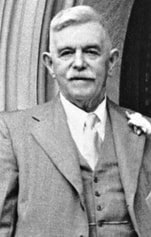
| news_item_1940_0001.pdf | |
| File Size: | 1457 kb |
| File Type: | |
Patricia Pinnock {nee Cam} & the Cam Flan
 Miss Patricia Cam doing the honours
Miss Patricia Cam doing the honours
Miss Patricia Cam was the granddaughter of the owner. Born in 1926, she became Mrs Pinnock and was Top Agency Development Manager of the NSW Building Society. Mother of Adrian Bryce, Simon John & Adam Rocco she passed away in 1999 and is interred at South Head Cemetery.
Gwen Dundon recalls:-
The Cam [Caminiti] family had a remarkable history and you are probably aware of it. They were part of the Marquis de Rays’ ill-fated settlement venture to Port Breton, and were brought to Sydney to save their lives, then went to live on the NSW north coast in 1882, an area which became known as New Italy.
Another Italian family from the same expedition, was employed by timber merchants, the Fagan Bros, of Gosford and Sydney, and brought to the family home at West Gosford – the mother as housekeeper, the father as orchardist etc. There had been a call by Premier Parkes for people to give the survivors work and accommodation. The Fagans (convict father) were the people who took in the Australian poet Henry Kendall when he was sick and down on his luck in the 1870s, and cared for him at their farm until he was back on his feet. Some of his best-known poems were written in this district.
Gwen Dundon recalls:-
The Cam [Caminiti] family had a remarkable history and you are probably aware of it. They were part of the Marquis de Rays’ ill-fated settlement venture to Port Breton, and were brought to Sydney to save their lives, then went to live on the NSW north coast in 1882, an area which became known as New Italy.
Another Italian family from the same expedition, was employed by timber merchants, the Fagan Bros, of Gosford and Sydney, and brought to the family home at West Gosford – the mother as housekeeper, the father as orchardist etc. There had been a call by Premier Parkes for people to give the survivors work and accommodation. The Fagans (convict father) were the people who took in the Australian poet Henry Kendall when he was sick and down on his luck in the 1870s, and cared for him at their farm until he was back on his feet. Some of his best-known poems were written in this district.
 Rocco, Gladys & Patricia Cam
Rocco, Gladys & Patricia Cam
Patricia Cam was born in Sydney on 21st October 1926 so would have been 14, in the photograph at left, taken on the day of the launch of the Pat Cam. Her father was Rocco Edmund Caminiti (1905–1961) and her mother Gladys White (–1994).
Patricia Cam had two brothers - Donald Edmund Cam (1931–2017) who would have been 9 in the photo and Allan Rocco Cam (1934–1988) who would have been six - the older child is standing in front of Patricia Cam and the lady to her right - presumably her mother Gladys.
Patricia married John Pinnock on 30 June 1950. Their first child Adrian Bryce was born at Mater Misericordiae private maternity hospital in Sydney to be followed by Simon John & Adam Rocco. She passed away on 29th September 1999 and is interred South Head Cemetery Section W – Row 2.
Patricia Olive Cam
Birth 21 OCT 1926 • Sydney NSW Australia
Mother Gladys White – 19 Sept 1994
Father Rocco Edmund Caminiti 1905-1961
Siblings Rocco Edmund Caminiti (Donald Edmund) 1931 - 28/4/2017 & Allan Rocco Cam 1934-1988
Married John Pinnock who died ~2013
Children Adrian Bryce, Simon John & Adam Rocco
Died 29 Sept 1999, formerly of Dover Heights, late of Bayview
Buried South Head Cemetery Section W – Row 2 (~Patricia Olive Cam-Pinnock)
On 31 May 1934, when aged 8, she travelled from Liverpool, England to Sydney aboard the Themistocles which probably coincides with the acquisition of one of the trawlers which Carlo purchased from the UK.
Patricia Cam had two brothers - Donald Edmund Cam (1931–2017) who would have been 9 in the photo and Allan Rocco Cam (1934–1988) who would have been six - the older child is standing in front of Patricia Cam and the lady to her right - presumably her mother Gladys.
Patricia married John Pinnock on 30 June 1950. Their first child Adrian Bryce was born at Mater Misericordiae private maternity hospital in Sydney to be followed by Simon John & Adam Rocco. She passed away on 29th September 1999 and is interred South Head Cemetery Section W – Row 2.
Patricia Olive Cam
Birth 21 OCT 1926 • Sydney NSW Australia
Mother Gladys White – 19 Sept 1994
Father Rocco Edmund Caminiti 1905-1961
Siblings Rocco Edmund Caminiti (Donald Edmund) 1931 - 28/4/2017 & Allan Rocco Cam 1934-1988
Married John Pinnock who died ~2013
Children Adrian Bryce, Simon John & Adam Rocco
Died 29 Sept 1999, formerly of Dover Heights, late of Bayview
Buried South Head Cemetery Section W – Row 2 (~Patricia Olive Cam-Pinnock)
On 31 May 1934, when aged 8, she travelled from Liverpool, England to Sydney aboard the Themistocles which probably coincides with the acquisition of one of the trawlers which Carlo purchased from the UK.
The Caminiti Family - New Italy
|
|
Rocco Caminiti (also spelt Comminitti and Caminotti) was an Italian who, in 1882, was sailing on a Grafton Steam Navigation Company ship along the New South Wales coast when he either heard or saw that land was open for selection along the Richmond River. In April 1882, he took Antonio Pezzutti back to the area and they selected land close to a creek on the South Woodburn-Chatsworth Island road. This was the beginning of New Italy. Among the other families who arrived to take up selections were the Gavas, among them Catherina or Catherine. She and Rocco Caminiti became the founding parents of the Cam family.
Rocco Caminiti was not one of the group of Italian settlers who made up most of the New Italy community who had been betrayed by the Marquis de Rays and his officials in the New France project, and who arrived destitute in Sydney on the James Paterson on 7 April 1881. However, he did arrive around that time. His 1903 naturalisation certificate states that, a native of Italy, aged 53, he had arrived on the Sanif 22 years before, in 1881. His death certificate (1907) stated he had been born in Galico, Marina, Italy, the son of Carlo Caminiti, engineer, and Lettiria de Pasquale, and had been in New South Wales about 23 years, making his arrival 1884, but his own testimony from the naturalisation certificate is probably more reliable. The death certificate states he and Catherina (Kate) Gava were married in Sydney, NSW, when Rocco was 29 years old. Unfortunately, cross-referencing these details gives a year of birth for Rocco of 1849 or 1850 and, if he married at 29 years of age, this would have been in 1878 or 1879, when neither he nor Catherina were in Australia.
Rocco Caminiti was not one of the group of Italian settlers who made up most of the New Italy community who had been betrayed by the Marquis de Rays and his officials in the New France project, and who arrived destitute in Sydney on the James Paterson on 7 April 1881. However, he did arrive around that time. His 1903 naturalisation certificate states that, a native of Italy, aged 53, he had arrived on the Sanif 22 years before, in 1881. His death certificate (1907) stated he had been born in Galico, Marina, Italy, the son of Carlo Caminiti, engineer, and Lettiria de Pasquale, and had been in New South Wales about 23 years, making his arrival 1884, but his own testimony from the naturalisation certificate is probably more reliable. The death certificate states he and Catherina (Kate) Gava were married in Sydney, NSW, when Rocco was 29 years old. Unfortunately, cross-referencing these details gives a year of birth for Rocco of 1849 or 1850 and, if he married at 29 years of age, this would have been in 1878 or 1879, when neither he nor Catherina were in Australia.
Catherina Gava came to Australia with her family on the James Paterson, when she was 17 years old (that is, she was born about 1864; her naturalisation certificate states 18 July 1865). Her mother, Maria, had been widowed on the voyage, Giovanni Gava having died in December 1880 after the ship carrying the settlers had arrived at Port Breton, New France (located on New Ireland, now a part of Papua New Guinea), one of the many who did not survive the voyage and short stay at Port Breton. The Gavas were from Venice, according to the 1901 naturalisation record of Santo Gava, more precisely Santa Fiora, according to Catherinaís 1912 naturalisation certificate. The certificate provides some inaccurate information; for example that she arrived at Sydney on a vessel, the Milan, from Noumea on 2 March 1881; no such vessel arrived in Sydney around that date and she is definitely recorded among the James Paterson passengers- who did indeed come via Noumea who arrived on 7 April 1881.
At NEW ITALY Rocco’s land was centrally located among the acreage taken up by the New Italy settlers, 40 acres opposite the public school site. Children Rosilia and Carlo were born there in 1884 and John in 1886. The next child, Mary, recorded in the Registry indexes as surname, was born in Sydney in 1889, indicating the family had moved there between 1886 and 1889. Further children Joseph (1891), Antoinette (1893), Rocco (1895), Albert (1897) and Thomas (1901) are recorded as born in Balmain, Balmain South or Rozelle, all inner western suburbs of Sydney.
Rocco Caminiti had taken to the sea and become a fisherman, and this was his listed occupation at the time of his death, 25 July 1907, at Lakelands, near Wollongong. It was also his occupation recorded in 1890-91 when he was residing at 43 and 41 Foucart Street, Rozelle, but he was recorded as a greengrocer at 40 Denison Street, Rozelle in 1897, where he remained until at least 1904. Catherine is recorded as a greengrocer at the same address from 1905 until 1912, and at four other addresses in the same street, and in Datchett Street, until 1931*. In 1913 there was a fish shop run by the Caminiti brothers at 675 Darling Street, Balmain, and from 1913-1915 a fish shop under the proprietorship of John Caminiti at 697 Darling Street, Balmain. In 1912, when Catherine Caminiti was naturalised, 3 of her children were married (Carlo 1904, Rosilia 1907 and Mary 1911) and 6 single (John, Joseph, Antoinette, Rocco, Albert and Thomas). All the single children were living with her. Catherine died in 1932 at Balmain.
One of her children pre-deceased her: John had enlisted in the AIF in 1915 at the age of 31 years, and had been killed at Messines, Belgium, on 10 June 1917. His brother, Albert, also enlisted , in 1916, and survived to serve also in the Second World War. A cousin, Anthony Mazzer, also served in the First World War and was awarded the Military Medal for actions in September 1918. By the time of Catherine’s death the firm of Cam and Sons – Caminiti having been shortened to Cam in the meantime was a prosperous fishing business operating out of Sydney, owning a number of ocean-going trawlers. Rocco’s son, Carlo known as Charlie Cam, built up the business in the 1920s and 1930s. During the Second World War eight of Cam and Sons fishing trawlers were requisitioned and converted for military purposes by the Royal Australian Navy. Among them were the Patricia Cam, Mary Cam, Alfie Cam, Olive Cam, Keith Cam and Goorangai.
Rocco Caminiti had taken to the sea and become a fisherman, and this was his listed occupation at the time of his death, 25 July 1907, at Lakelands, near Wollongong. It was also his occupation recorded in 1890-91 when he was residing at 43 and 41 Foucart Street, Rozelle, but he was recorded as a greengrocer at 40 Denison Street, Rozelle in 1897, where he remained until at least 1904. Catherine is recorded as a greengrocer at the same address from 1905 until 1912, and at four other addresses in the same street, and in Datchett Street, until 1931*. In 1913 there was a fish shop run by the Caminiti brothers at 675 Darling Street, Balmain, and from 1913-1915 a fish shop under the proprietorship of John Caminiti at 697 Darling Street, Balmain. In 1912, when Catherine Caminiti was naturalised, 3 of her children were married (Carlo 1904, Rosilia 1907 and Mary 1911) and 6 single (John, Joseph, Antoinette, Rocco, Albert and Thomas). All the single children were living with her. Catherine died in 1932 at Balmain.
One of her children pre-deceased her: John had enlisted in the AIF in 1915 at the age of 31 years, and had been killed at Messines, Belgium, on 10 June 1917. His brother, Albert, also enlisted , in 1916, and survived to serve also in the Second World War. A cousin, Anthony Mazzer, also served in the First World War and was awarded the Military Medal for actions in September 1918. By the time of Catherine’s death the firm of Cam and Sons – Caminiti having been shortened to Cam in the meantime was a prosperous fishing business operating out of Sydney, owning a number of ocean-going trawlers. Rocco’s son, Carlo known as Charlie Cam, built up the business in the 1920s and 1930s. During the Second World War eight of Cam and Sons fishing trawlers were requisitioned and converted for military purposes by the Royal Australian Navy. Among them were the Patricia Cam, Mary Cam, Alfie Cam, Olive Cam, Keith Cam and Goorangai.

The Patricia Cam, built locally in 1940, was named after the daughter of Rocco Cam, Charlie’s son. Rocco was a director in Cam and Sons and later established his own successful business, R E Cam and Sons. By the time the Patricia Cam was commissioned the Goorangai had already been sunk when struck accidentally in Port Phillip Bay by the troopship MV Duntroon on the night of 20 November 1940. It had been doing duty off the Victorian coast, clearing mines laid by a German raider that had sunk two ships. All 24 hands were killed. A memorial cairn to the Goorangai and her crew was erected at Queenscliff in 1981. The Patricia Cam was itself sunk on 22 January 1943 off the Northern Territory coast with the lost of another half a dozen lives. The Goorangai and minesweepers and the Patricia Cam are among the Navy ships commemorated by bronze plaques in the gardens around the Shrine of Remembrance in Melbourne. That for the Pat Cam records, under the insignia of the Royal Australian Navy, that it was lost in action, January 22nd 1943.
The Cam family prospered again after the Second World War. From among the requisitioned vessels Cam and Sons re-purchased the Olive Cam at least, in 1946, and returned it to work as a fishing trawler. She ran aground in stormy weather and sank south of Eden, on the New South Wales coast, in November 1954. The wreck is now a recognised scuba diving location, as is the Goorangai site, designated a Historic Shipwreck in 1995. The location of the wreck of the Patricia Cam is documented, but is sufficiently isolated for it to be briefly confused in 2002 with the similarly-sized Sanyo Maru, a Japanese pearling ship sunk in a gale in the same waters in 1937. In 1961 the Cam operations were described as a vast business enterprise in the fishing and allied industries, and R E Cam and Sons was advertised as the largest State-wide wholesaler of quick-frozen foods and sole distribution agent for a range of products. However, the business was sold some time later and the name ceased to be identified with a distinct enterprise. Family descendants have now diversified into a wide range of occupations within broader Australian society.
The Cam family prospered again after the Second World War. From among the requisitioned vessels Cam and Sons re-purchased the Olive Cam at least, in 1946, and returned it to work as a fishing trawler. She ran aground in stormy weather and sank south of Eden, on the New South Wales coast, in November 1954. The wreck is now a recognised scuba diving location, as is the Goorangai site, designated a Historic Shipwreck in 1995. The location of the wreck of the Patricia Cam is documented, but is sufficiently isolated for it to be briefly confused in 2002 with the similarly-sized Sanyo Maru, a Japanese pearling ship sunk in a gale in the same waters in 1937. In 1961 the Cam operations were described as a vast business enterprise in the fishing and allied industries, and R E Cam and Sons was advertised as the largest State-wide wholesaler of quick-frozen foods and sole distribution agent for a range of products. However, the business was sold some time later and the name ceased to be identified with a distinct enterprise. Family descendants have now diversified into a wide range of occupations within broader Australian society.
Michael McFadyen
|
|
By 1938 the company had nine trawlers. After the start of World War II and due probably to the fact that Italy was now at war with Australia, Carlos Caminetti, changed his name officially to Charles Cam by Deed Poll on 31 July 1940.
During World War II many of the company's trawlers were requisitioned for service as auxiliary minesweepers. In fact, of Australia's 35 requisitioned auxiliary minesweepers, eight came from the Cam and Sons fleet.
During World War II many of the company's trawlers were requisitioned for service as auxiliary minesweepers. In fact, of Australia's 35 requisitioned auxiliary minesweepers, eight came from the Cam and Sons fleet.
Len Gairns

Come on Debby
|
|
|
|
||||||||||||||||||||||||||||||||||||
Petty Officer Winston John 'Mad Jack' Jensen Coastwatcher
Special Intelligence Service
|
|
|
|
||||||||||||||||||||||||
|
|
|
|
||||||||||||||||||||||||
| alan_gill_smh_article_1993.pdf | |
| File Size: | 99 kb |
| File Type: | |


